
Lower Danube Discovery with Turkey
Lower Danube Discovery with Turkey
Cruise overview
WHY BOOK WITH US?
- ✔ The Deluxe Cruises’ team has extensive experience in ultra-luxury cruising.
- ✔ Call now to speak to our helpful and experienced Cruise Concierge team.
- ✔ Enjoy our Unique Deluxe Cruises Bonus for substantial savings.
- ✔ Our team will tailor your holiday to your exacting requirements.
- ✔ As agents, we work under the protection of each cruise lines ABTA / ATOL licences
About Istanbul
The only city in the world that can lay claim to straddling two continents, Istanbul—once known as Constantinople, capital of the Byzantine and then the Ottoman Empire—has for centuries been a bustling metropolis with one foot in Europe and the other in Asia. Istanbul embraces this enviable position with both a certain chaos and inventiveness, ever evolving as one of the world’s most cosmopolitan crossroads. It’s often said that Istanbul is the meeting point of East and West, but visitors to this city built over the former capital of two great empires are likely to be just as impressed by the juxtaposition of old and new. Office towers creep up behind historic palaces, women in chic designer outfits pass others wearing long skirts and head coverings, peddlers’ pushcarts vie with battered old Fiats and shiny BMWs for dominance of the noisy, narrow streets, and the Grand Bazaar competes with modern shopping malls. At dawn, when the muezzin's call to prayer resounds from ancient minarets, there are inevitably a few hearty revelers still making their way home from nightclubs and bars. Most visitors to this sprawling city of more than 14 million will first set foot in the relatively compact Old City, where the legacy of the Byzantine and Ottoman empires can be seen in monumental works of architecture like the brilliant Aya Sofya and the beautifully proportioned mosques built by the great architect Sinan. Though it would be easy to spend days, if not weeks, exploring the wealth of attractions in the historical peninsula, visitors should make sure also to venture elsewhere in order to experience the vibrancy of contemporary Istanbul. With a lively nightlife propelled by its young population and an exciting arts scene that’s increasingly on the international radar—thanks in part to its stint as the European Capital of Culture in 2010—Istanbul is truly a city that never sleeps. It’s also a place where visitors will feel welcome: Istanbul may be on the Bosphorus, but at heart it’s a Mediterranean city, whose friendly inhabitants are effusively social and eager to share what they love most about it.




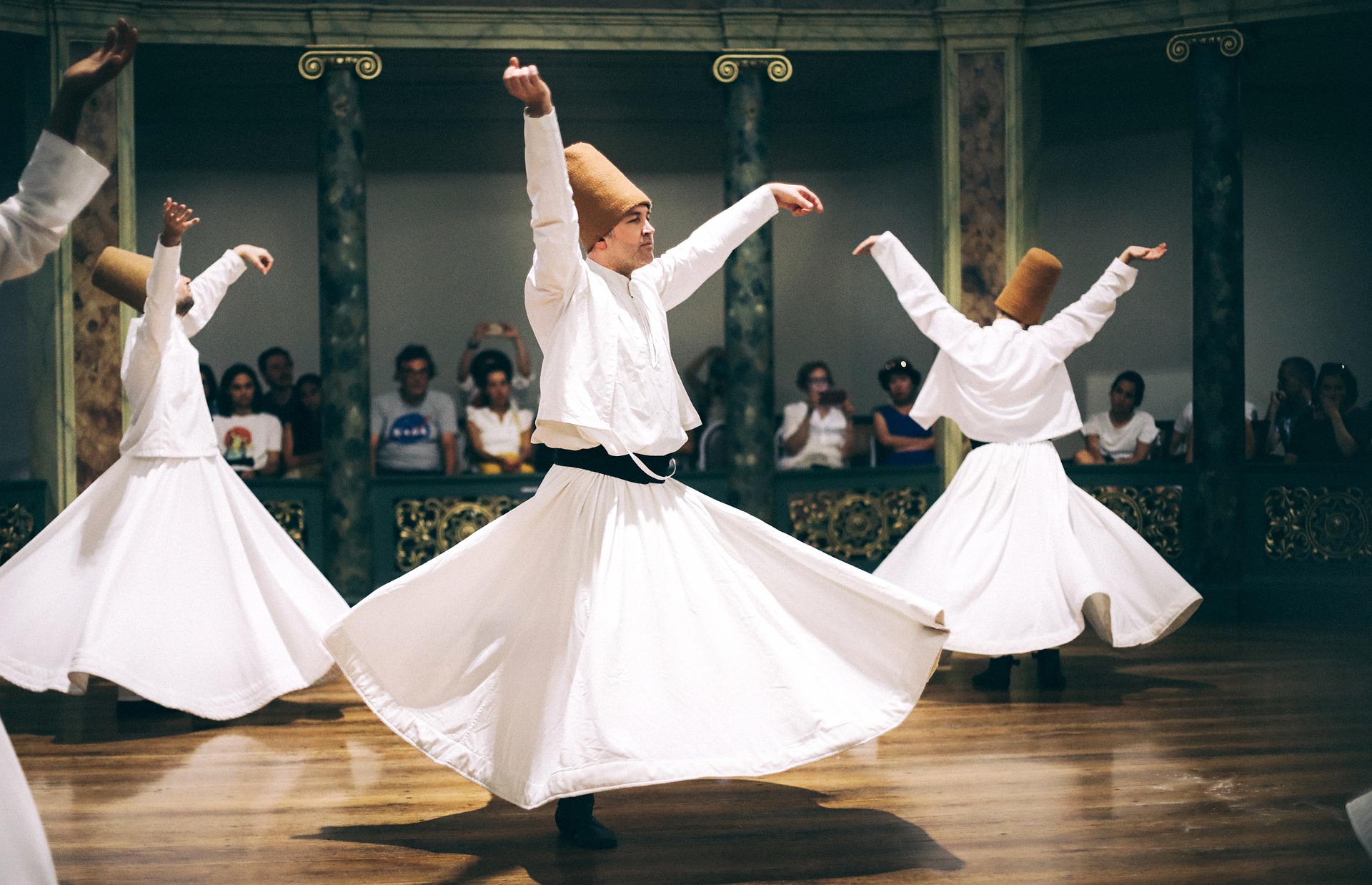



About Istanbul
The only city in the world that can lay claim to straddling two continents, Istanbul—once known as Constantinople, capital of the Byzantine and then the Ottoman Empire—has for centuries been a bustling metropolis with one foot in Europe and the other in Asia. Istanbul embraces this enviable position with both a certain chaos and inventiveness, ever evolving as one of the world’s most cosmopolitan crossroads. It’s often said that Istanbul is the meeting point of East and West, but visitors to this city built over the former capital of two great empires are likely to be just as impressed by the juxtaposition of old and new. Office towers creep up behind historic palaces, women in chic designer outfits pass others wearing long skirts and head coverings, peddlers’ pushcarts vie with battered old Fiats and shiny BMWs for dominance of the noisy, narrow streets, and the Grand Bazaar competes with modern shopping malls. At dawn, when the muezzin's call to prayer resounds from ancient minarets, there are inevitably a few hearty revelers still making their way home from nightclubs and bars. Most visitors to this sprawling city of more than 14 million will first set foot in the relatively compact Old City, where the legacy of the Byzantine and Ottoman empires can be seen in monumental works of architecture like the brilliant Aya Sofya and the beautifully proportioned mosques built by the great architect Sinan. Though it would be easy to spend days, if not weeks, exploring the wealth of attractions in the historical peninsula, visitors should make sure also to venture elsewhere in order to experience the vibrancy of contemporary Istanbul. With a lively nightlife propelled by its young population and an exciting arts scene that’s increasingly on the international radar—thanks in part to its stint as the European Capital of Culture in 2010—Istanbul is truly a city that never sleeps. It’s also a place where visitors will feel welcome: Istanbul may be on the Bosphorus, but at heart it’s a Mediterranean city, whose friendly inhabitants are effusively social and eager to share what they love most about it.








About Istanbul
The only city in the world that can lay claim to straddling two continents, Istanbul—once known as Constantinople, capital of the Byzantine and then the Ottoman Empire—has for centuries been a bustling metropolis with one foot in Europe and the other in Asia. Istanbul embraces this enviable position with both a certain chaos and inventiveness, ever evolving as one of the world’s most cosmopolitan crossroads. It’s often said that Istanbul is the meeting point of East and West, but visitors to this city built over the former capital of two great empires are likely to be just as impressed by the juxtaposition of old and new. Office towers creep up behind historic palaces, women in chic designer outfits pass others wearing long skirts and head coverings, peddlers’ pushcarts vie with battered old Fiats and shiny BMWs for dominance of the noisy, narrow streets, and the Grand Bazaar competes with modern shopping malls. At dawn, when the muezzin's call to prayer resounds from ancient minarets, there are inevitably a few hearty revelers still making their way home from nightclubs and bars. Most visitors to this sprawling city of more than 14 million will first set foot in the relatively compact Old City, where the legacy of the Byzantine and Ottoman empires can be seen in monumental works of architecture like the brilliant Aya Sofya and the beautifully proportioned mosques built by the great architect Sinan. Though it would be easy to spend days, if not weeks, exploring the wealth of attractions in the historical peninsula, visitors should make sure also to venture elsewhere in order to experience the vibrancy of contemporary Istanbul. With a lively nightlife propelled by its young population and an exciting arts scene that’s increasingly on the international radar—thanks in part to its stint as the European Capital of Culture in 2010—Istanbul is truly a city that never sleeps. It’s also a place where visitors will feel welcome: Istanbul may be on the Bosphorus, but at heart it’s a Mediterranean city, whose friendly inhabitants are effusively social and eager to share what they love most about it.








About Çanakkale
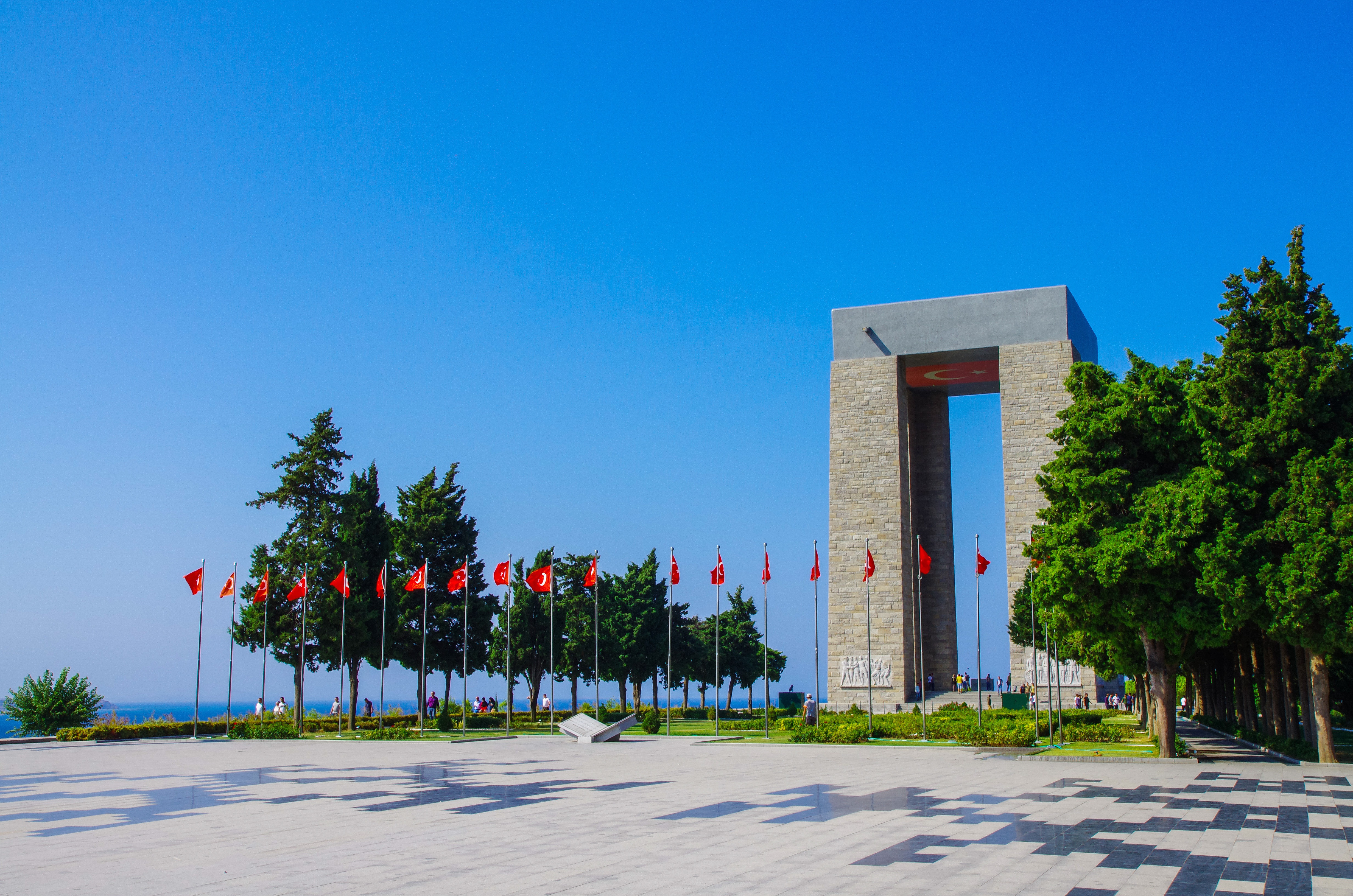
About Çanakkale

About Çanakkale

About Istanbul
The only city in the world that can lay claim to straddling two continents, Istanbul—once known as Constantinople, capital of the Byzantine and then the Ottoman Empire—has for centuries been a bustling metropolis with one foot in Europe and the other in Asia. Istanbul embraces this enviable position with both a certain chaos and inventiveness, ever evolving as one of the world’s most cosmopolitan crossroads. It’s often said that Istanbul is the meeting point of East and West, but visitors to this city built over the former capital of two great empires are likely to be just as impressed by the juxtaposition of old and new. Office towers creep up behind historic palaces, women in chic designer outfits pass others wearing long skirts and head coverings, peddlers’ pushcarts vie with battered old Fiats and shiny BMWs for dominance of the noisy, narrow streets, and the Grand Bazaar competes with modern shopping malls. At dawn, when the muezzin's call to prayer resounds from ancient minarets, there are inevitably a few hearty revelers still making their way home from nightclubs and bars. Most visitors to this sprawling city of more than 14 million will first set foot in the relatively compact Old City, where the legacy of the Byzantine and Ottoman empires can be seen in monumental works of architecture like the brilliant Aya Sofya and the beautifully proportioned mosques built by the great architect Sinan. Though it would be easy to spend days, if not weeks, exploring the wealth of attractions in the historical peninsula, visitors should make sure also to venture elsewhere in order to experience the vibrancy of contemporary Istanbul. With a lively nightlife propelled by its young population and an exciting arts scene that’s increasingly on the international radar—thanks in part to its stint as the European Capital of Culture in 2010—Istanbul is truly a city that never sleeps. It’s also a place where visitors will feel welcome: Istanbul may be on the Bosphorus, but at heart it’s a Mediterranean city, whose friendly inhabitants are effusively social and eager to share what they love most about it.








About Istanbul
The only city in the world that can lay claim to straddling two continents, Istanbul—once known as Constantinople, capital of the Byzantine and then the Ottoman Empire—has for centuries been a bustling metropolis with one foot in Europe and the other in Asia. Istanbul embraces this enviable position with both a certain chaos and inventiveness, ever evolving as one of the world’s most cosmopolitan crossroads. It’s often said that Istanbul is the meeting point of East and West, but visitors to this city built over the former capital of two great empires are likely to be just as impressed by the juxtaposition of old and new. Office towers creep up behind historic palaces, women in chic designer outfits pass others wearing long skirts and head coverings, peddlers’ pushcarts vie with battered old Fiats and shiny BMWs for dominance of the noisy, narrow streets, and the Grand Bazaar competes with modern shopping malls. At dawn, when the muezzin's call to prayer resounds from ancient minarets, there are inevitably a few hearty revelers still making their way home from nightclubs and bars. Most visitors to this sprawling city of more than 14 million will first set foot in the relatively compact Old City, where the legacy of the Byzantine and Ottoman empires can be seen in monumental works of architecture like the brilliant Aya Sofya and the beautifully proportioned mosques built by the great architect Sinan. Though it would be easy to spend days, if not weeks, exploring the wealth of attractions in the historical peninsula, visitors should make sure also to venture elsewhere in order to experience the vibrancy of contemporary Istanbul. With a lively nightlife propelled by its young population and an exciting arts scene that’s increasingly on the international radar—thanks in part to its stint as the European Capital of Culture in 2010—Istanbul is truly a city that never sleeps. It’s also a place where visitors will feel welcome: Istanbul may be on the Bosphorus, but at heart it’s a Mediterranean city, whose friendly inhabitants are effusively social and eager to share what they love most about it.








About Istanbul
The only city in the world that can lay claim to straddling two continents, Istanbul—once known as Constantinople, capital of the Byzantine and then the Ottoman Empire—has for centuries been a bustling metropolis with one foot in Europe and the other in Asia. Istanbul embraces this enviable position with both a certain chaos and inventiveness, ever evolving as one of the world’s most cosmopolitan crossroads. It’s often said that Istanbul is the meeting point of East and West, but visitors to this city built over the former capital of two great empires are likely to be just as impressed by the juxtaposition of old and new. Office towers creep up behind historic palaces, women in chic designer outfits pass others wearing long skirts and head coverings, peddlers’ pushcarts vie with battered old Fiats and shiny BMWs for dominance of the noisy, narrow streets, and the Grand Bazaar competes with modern shopping malls. At dawn, when the muezzin's call to prayer resounds from ancient minarets, there are inevitably a few hearty revelers still making their way home from nightclubs and bars. Most visitors to this sprawling city of more than 14 million will first set foot in the relatively compact Old City, where the legacy of the Byzantine and Ottoman empires can be seen in monumental works of architecture like the brilliant Aya Sofya and the beautifully proportioned mosques built by the great architect Sinan. Though it would be easy to spend days, if not weeks, exploring the wealth of attractions in the historical peninsula, visitors should make sure also to venture elsewhere in order to experience the vibrancy of contemporary Istanbul. With a lively nightlife propelled by its young population and an exciting arts scene that’s increasingly on the international radar—thanks in part to its stint as the European Capital of Culture in 2010—Istanbul is truly a city that never sleeps. It’s also a place where visitors will feel welcome: Istanbul may be on the Bosphorus, but at heart it’s a Mediterranean city, whose friendly inhabitants are effusively social and eager to share what they love most about it.








About Bucharest
Bucharest, in southern Romania, is the country's capital and commercial center. Its iconic landmark is the massive, communist-era Palatul Parlamentului government building, which has 1,100 rooms. Nearby, the historic Lipscani district is home to an energetic nightlife scene as well as tiny Eastern Orthodox Stavropoleos Church and 15th-century Curtea Veche Palace, where Prince Vlad III (“The Impaler”) once ruled.
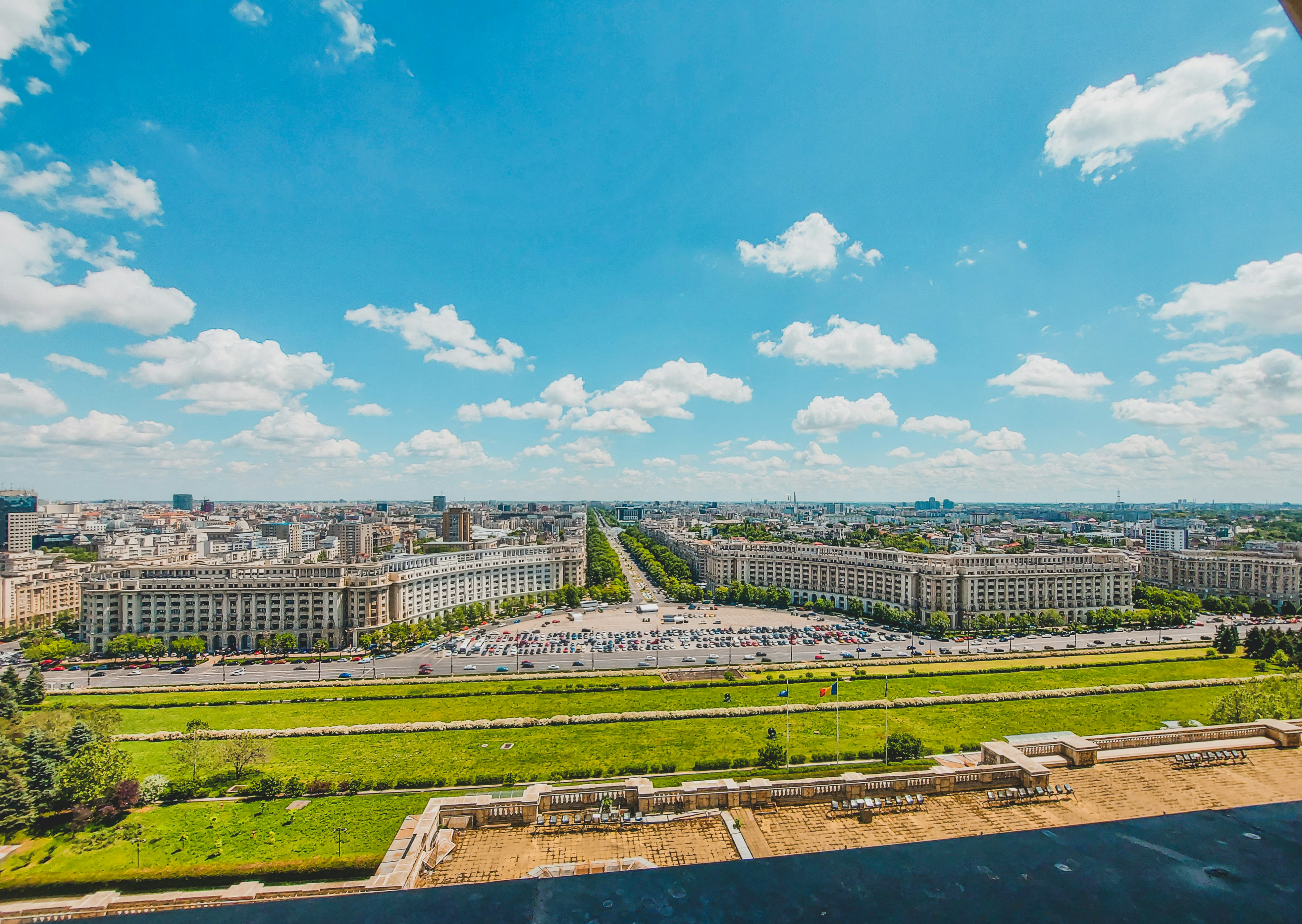
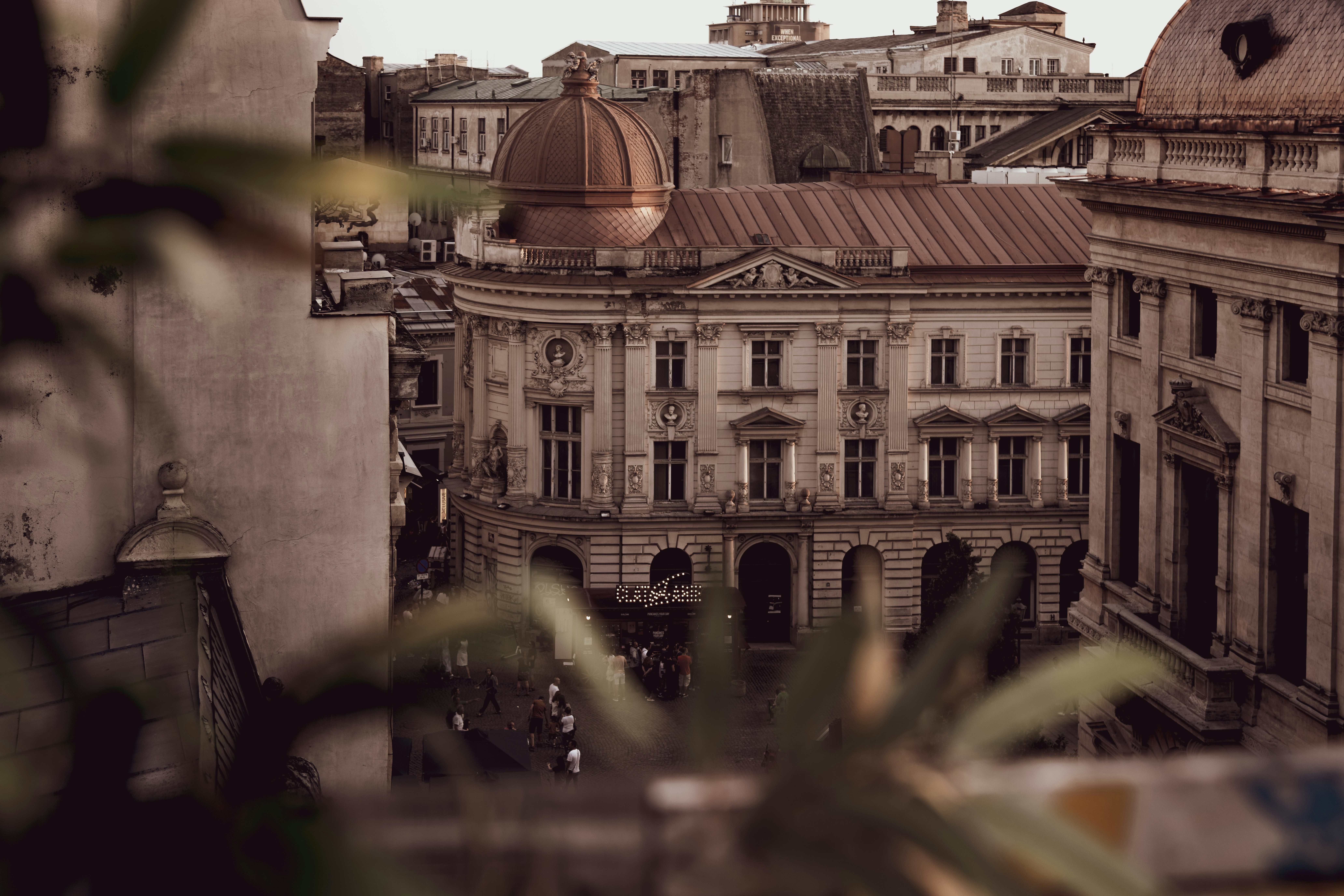
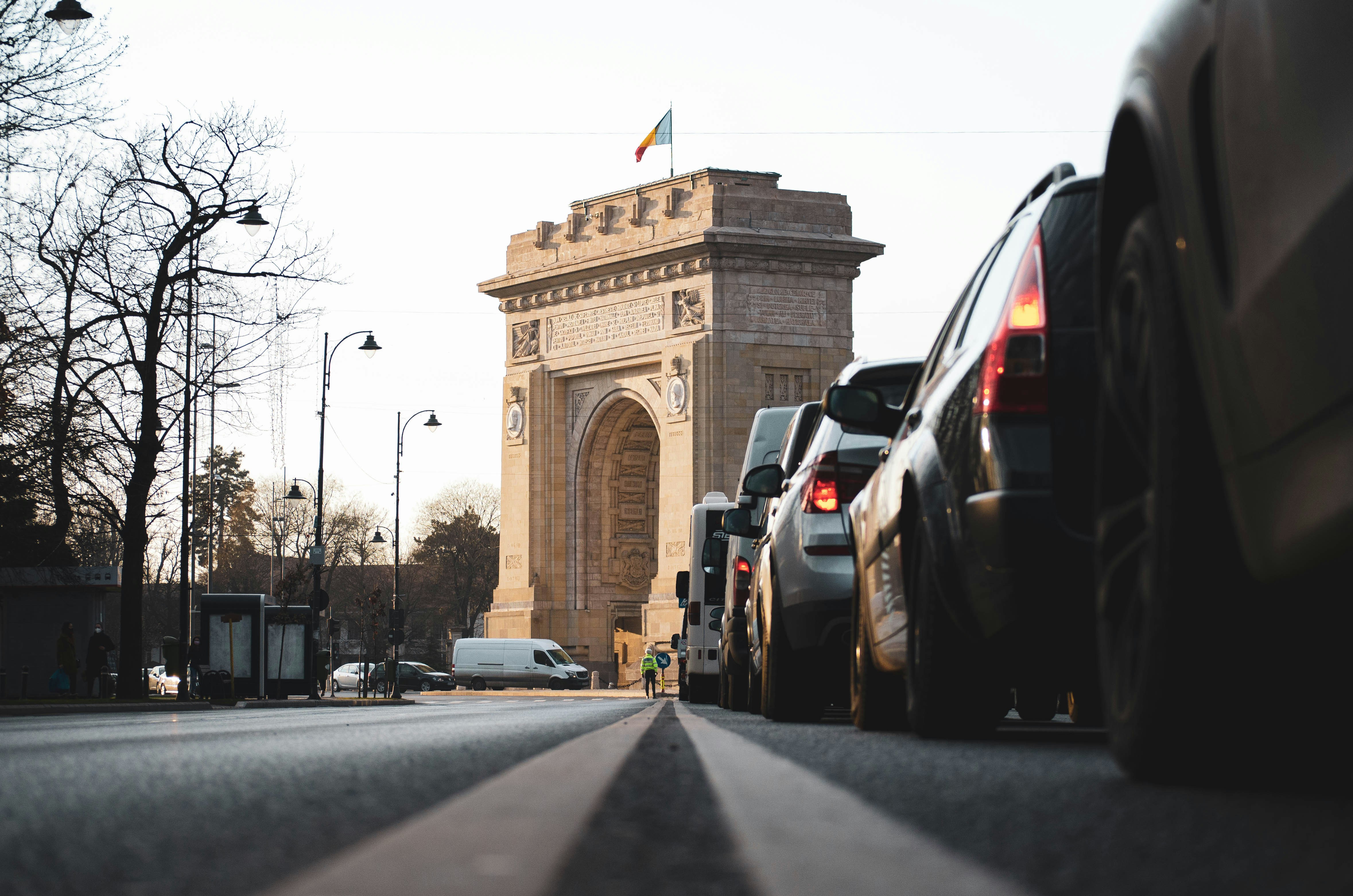
About Bucharest
Bucharest, in southern Romania, is the country's capital and commercial center. Its iconic landmark is the massive, communist-era Palatul Parlamentului government building, which has 1,100 rooms. Nearby, the historic Lipscani district is home to an energetic nightlife scene as well as tiny Eastern Orthodox Stavropoleos Church and 15th-century Curtea Veche Palace, where Prince Vlad III (“The Impaler”) once ruled.



About Constanta

About Constanta

About Silistra

About Ruse

About Vidin

About Golubac

About Iron Gates
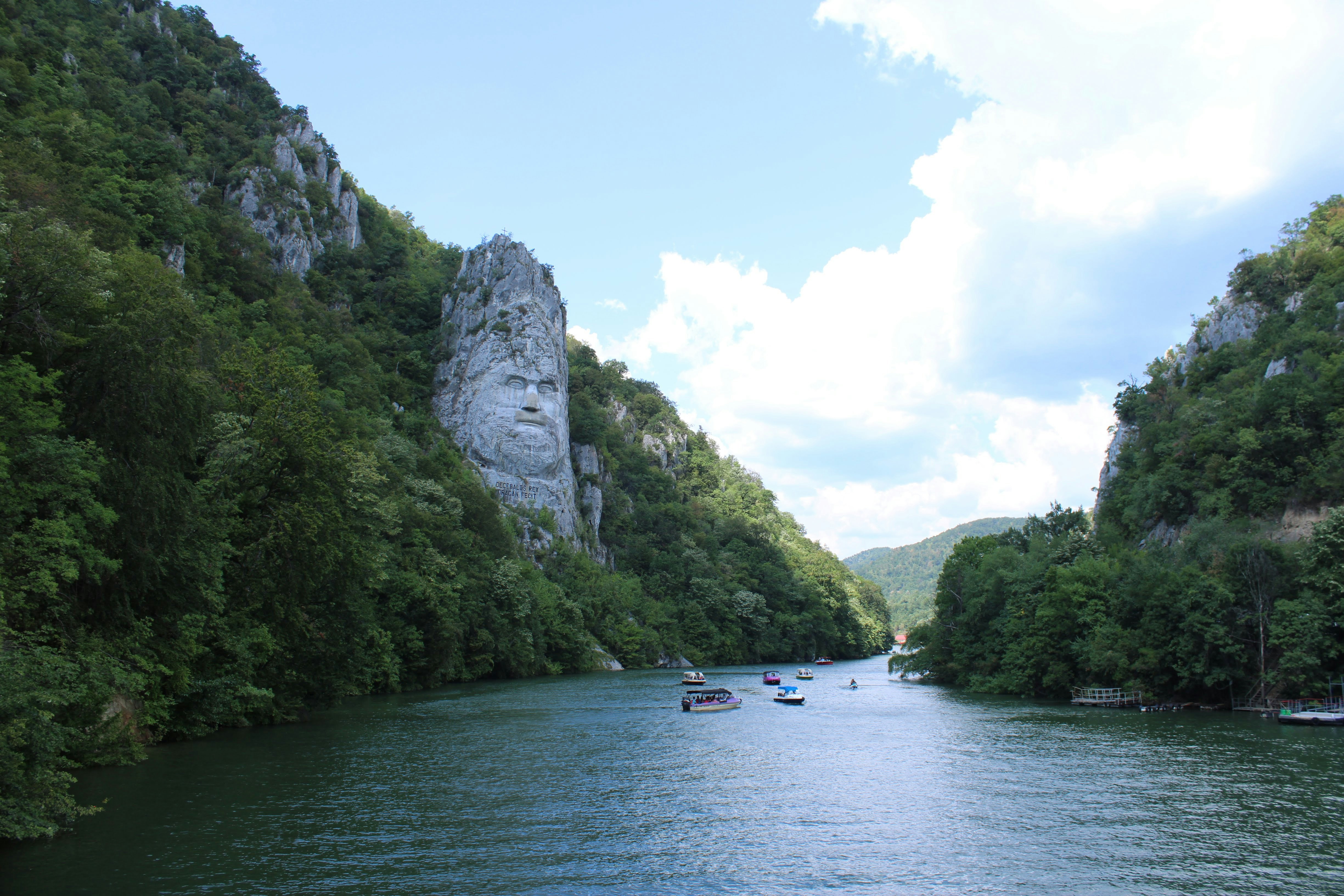
About Belgrade



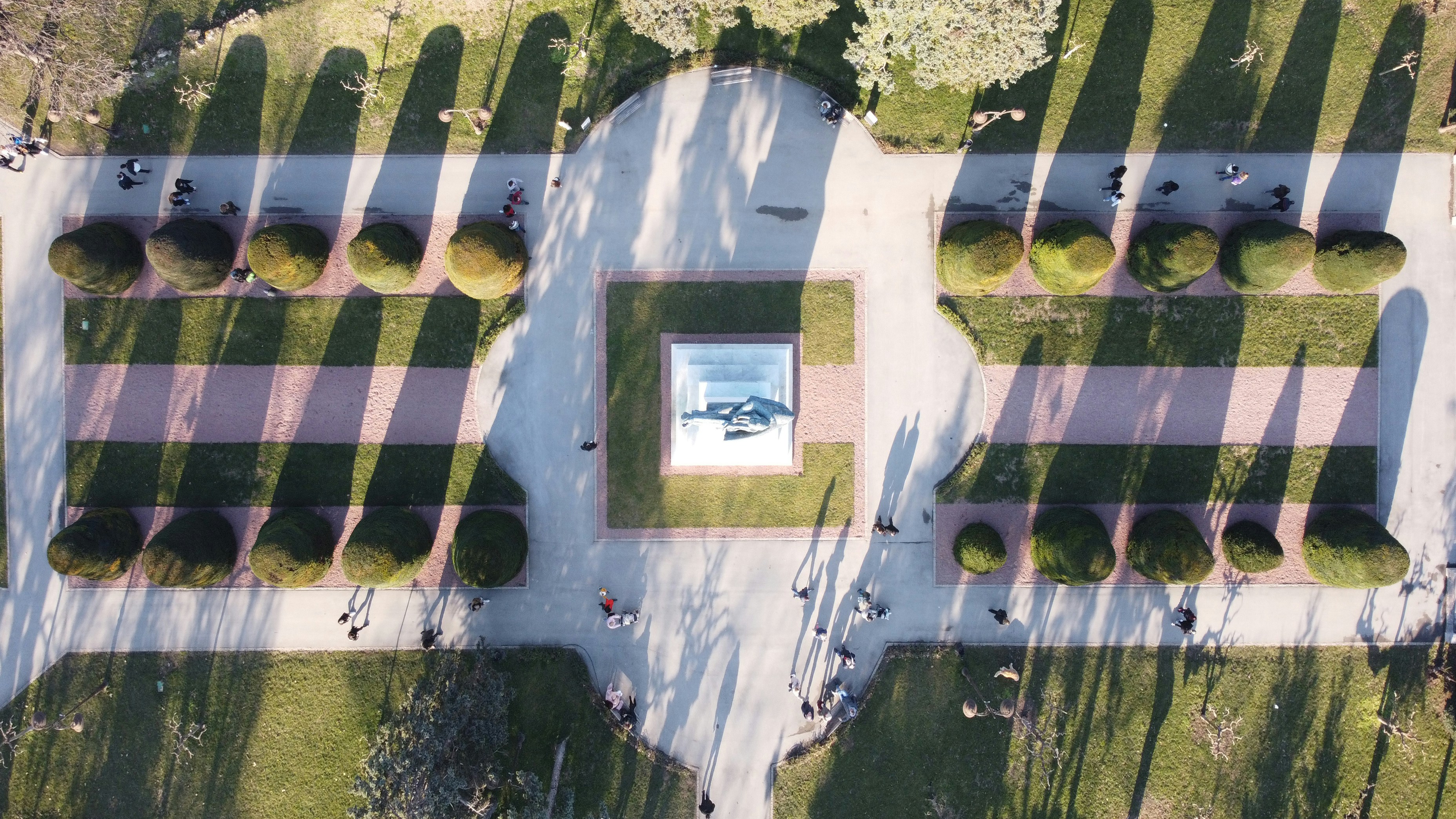


About Novi Sad

About Osijek
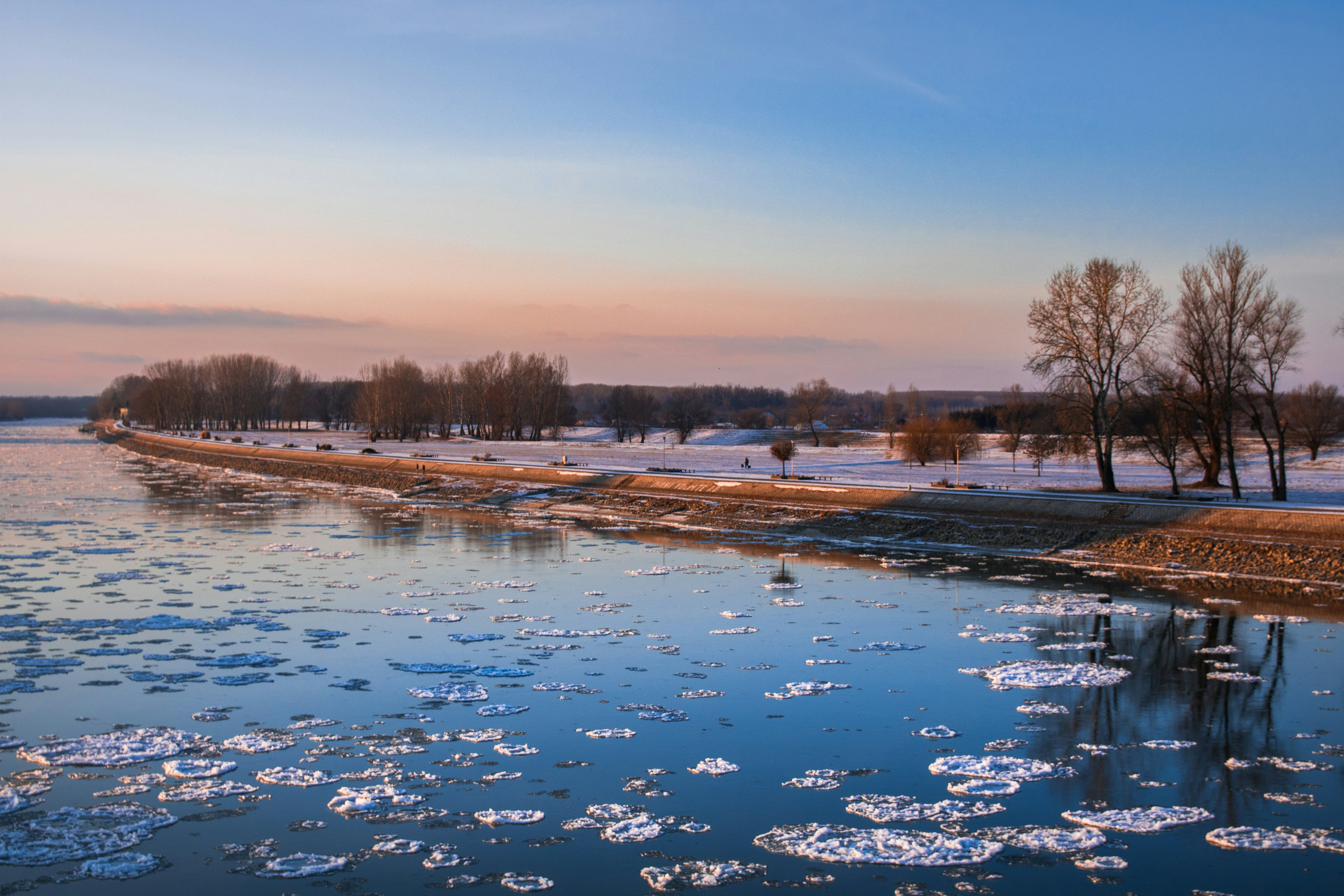
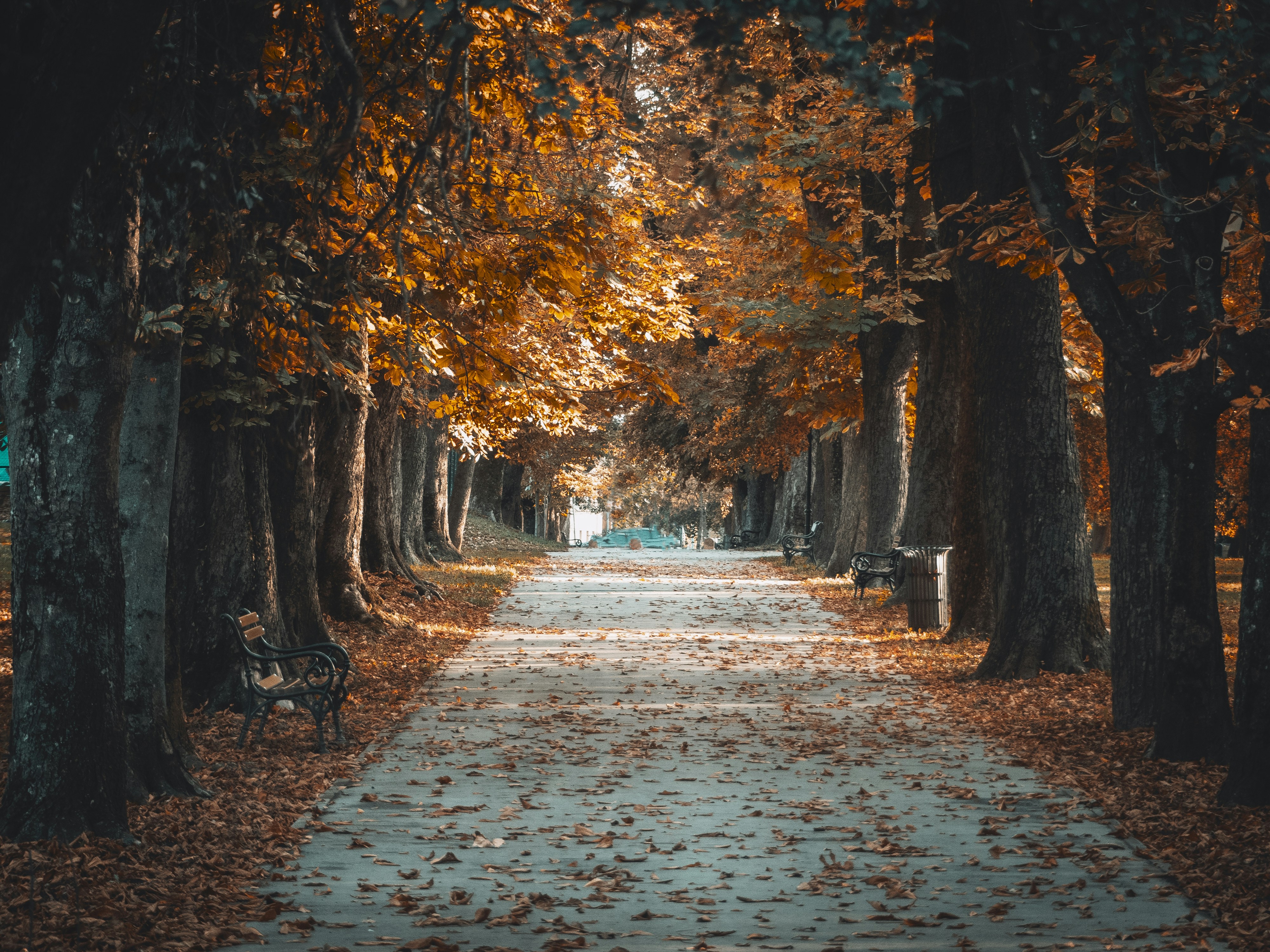


About Mohács

About Kalocsa
About Budapest
Budapest is the capital city of Hungary and is located over the River Danube. It is one of the largest cities in the European Union and much of its historical sites have been awarded UNESCO World Heritage Site status. Originally formed in 1873 by the joining of Buda, Pest and Old Buda, the city suffered heavy destruction during World War II and was rebuilt into the country's political, cultural and commercial hub it is now. Bridges and railways connect the city over the Danube, including the six small islands situated on the river themselves. Some of Budapest’s UNESCO World Heritage sites include Chain Bridge, Budapest Parliament, the striking Matthias church and the iconic Royal Palace visible from every location within Budapest City. The Castle Hills district architecture represents over a thousand years of the city's history with examples of Roman, Turkish, Gothic, Renaissance and Art Nouveau styles. Budapest also has a rich Jewish heritage and is home to the largest synagogue in Europe. The city has an abundance of restaurants offering international cuisines, as well as traditional Hungarian dishes ,including goulash soup, a very popular lunchtime dish. Hungarians enjoy their coffee so a traditional cafe is never hard to find.
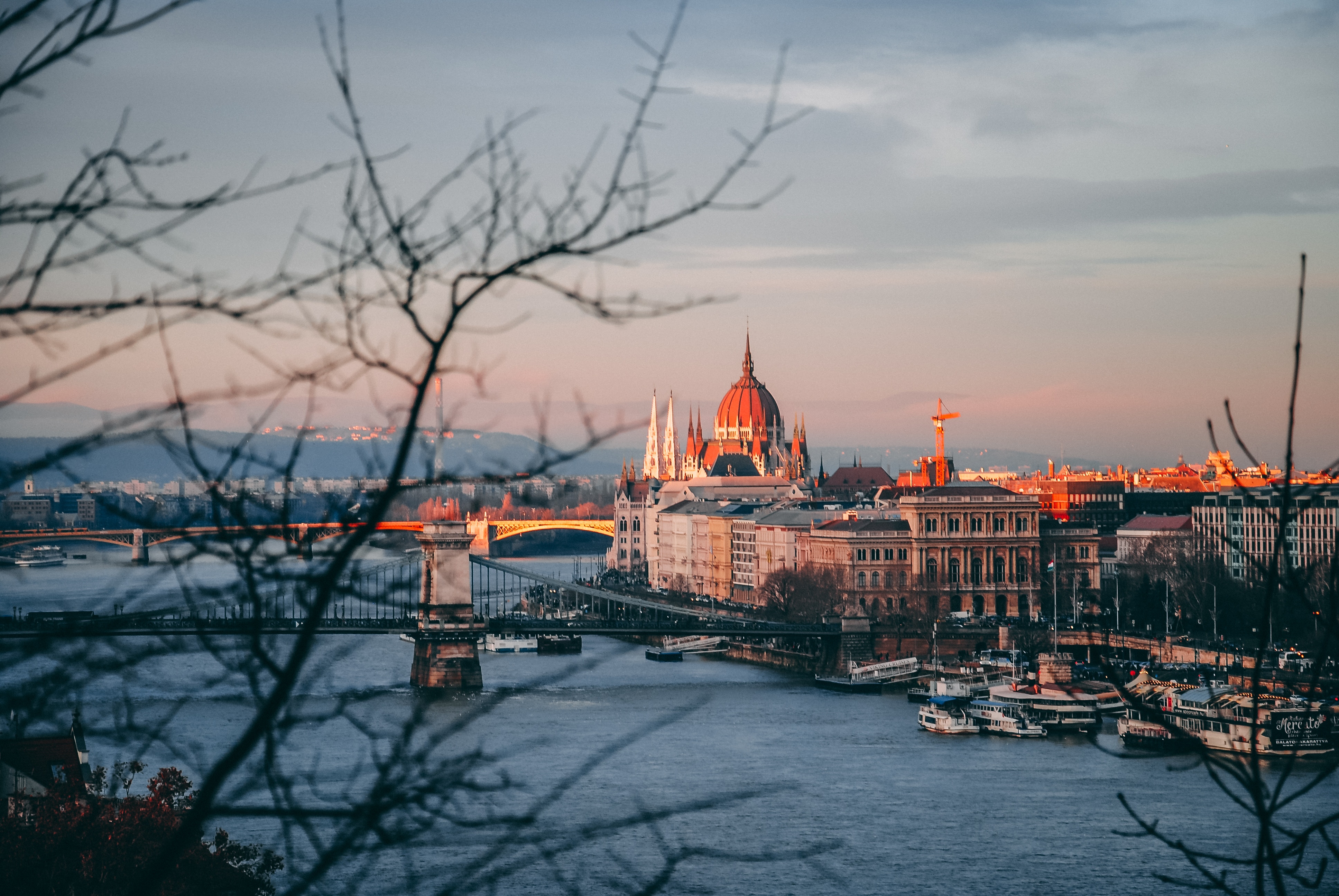

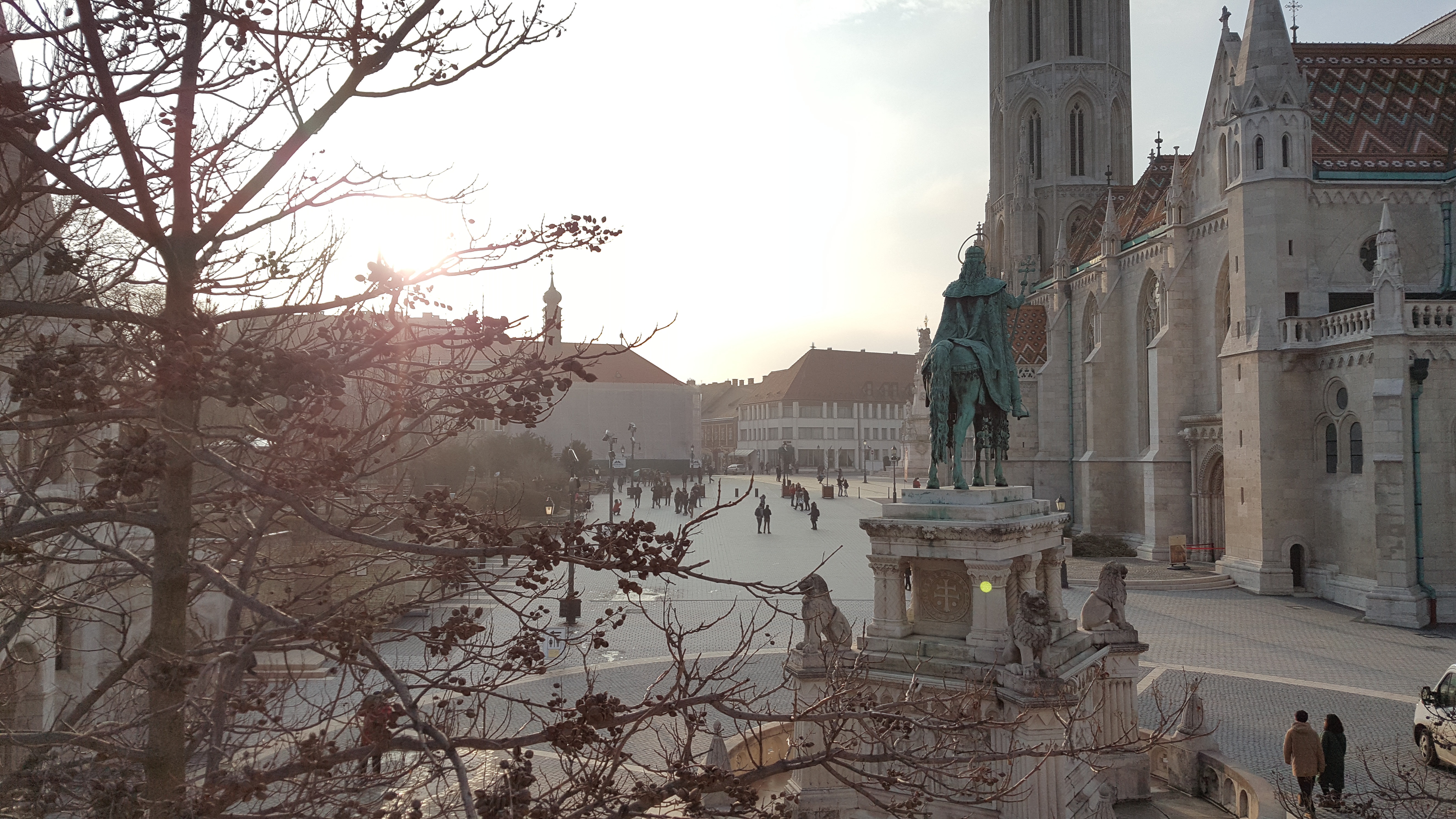

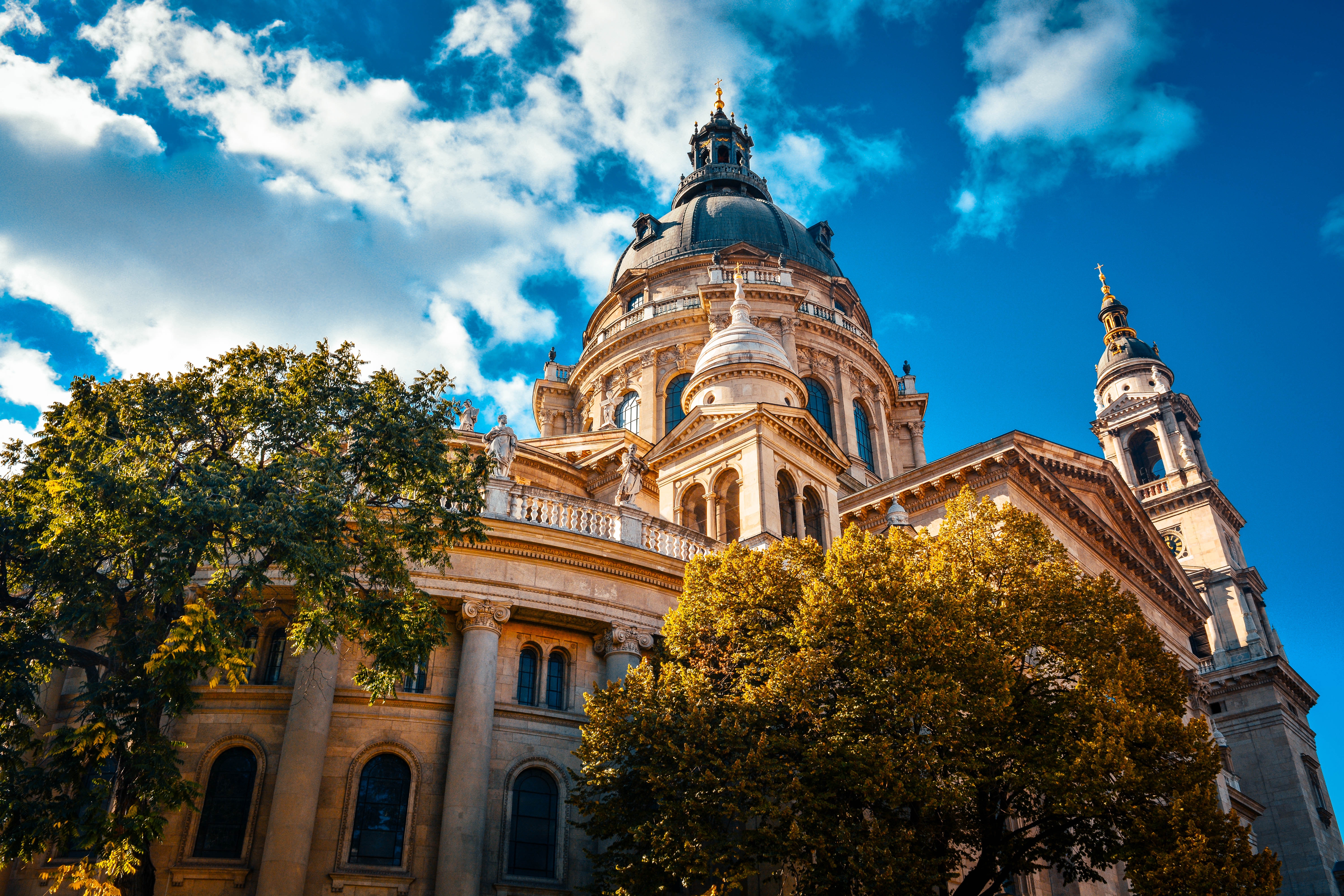
About Bratislava
Bratislava is the capital city of Slovakia and is located along the Danube a river on the borders of Austria and Hungary. The city is surrounded by the Little Carpathians Mountains and vineyards as well as its iconic reconstructed Bratislava Castle overlooking Old Town. The castle offers a picturesque view of the city, the neighbouring countries and is home to the Museum of History. Bratislava offers a blend of historic and modern attractions including the Old Town Hall, now home to the Bratislava City Museum, the UFO Bridge, Martin’s Cathedral, Michael’s Gate and Blue Church St Elizabeth’s. Bratislava is home to one of the oldest city parks in Central Europe and is popular with walkers, runners and cyclists as is the city forest park and foothills of the Carpathian Mountains. The city is popular for its locally brewed beers and has many micro-breweries and underground beer cellars. The local cuisine of Bratislava is an eclectic influence of European cultures including Slovak, Hungarian, Austrian and German and serves as a reminder of the history of this cosmopolitan city. However, visitors will find an array of offerings to suit all tastes with lunch being the main meal of the day and roast goose with lokse considered a signature dish of the area.


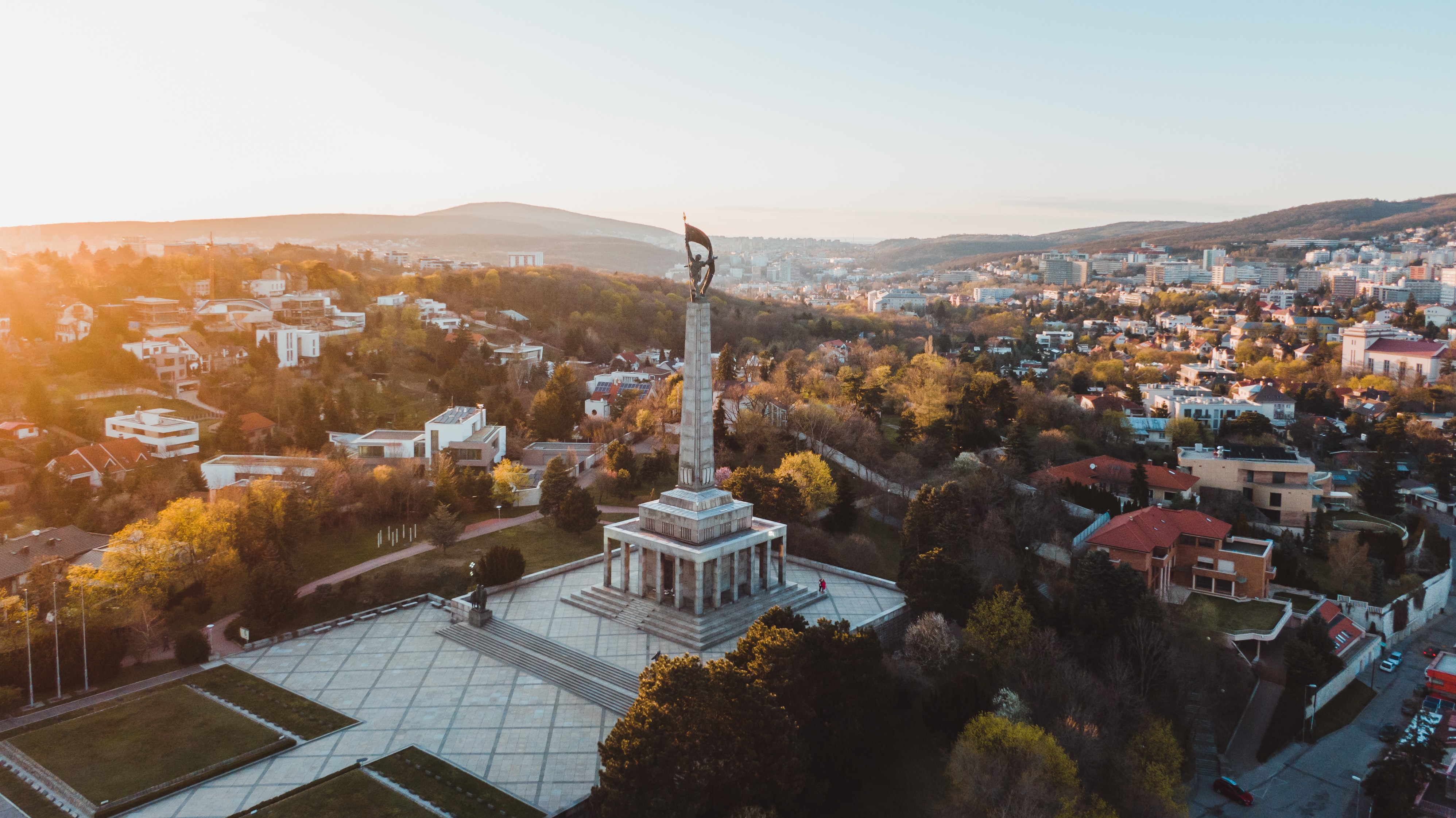



About Budapest
Budapest is the capital city of Hungary and is located over the River Danube. It is one of the largest cities in the European Union and much of its historical sites have been awarded UNESCO World Heritage Site status. Originally formed in 1873 by the joining of Buda, Pest and Old Buda, the city suffered heavy destruction during World War II and was rebuilt into the country's political, cultural and commercial hub it is now. Bridges and railways connect the city over the Danube, including the six small islands situated on the river themselves. Some of Budapest’s UNESCO World Heritage sites include Chain Bridge, Budapest Parliament, the striking Matthias church and the iconic Royal Palace visible from every location within Budapest City. The Castle Hills district architecture represents over a thousand years of the city's history with examples of Roman, Turkish, Gothic, Renaissance and Art Nouveau styles. Budapest also has a rich Jewish heritage and is home to the largest synagogue in Europe. The city has an abundance of restaurants offering international cuisines, as well as traditional Hungarian dishes ,including goulash soup, a very popular lunchtime dish. Hungarians enjoy their coffee so a traditional cafe is never hard to find.





About Budapest
Budapest is the capital city of Hungary and is located over the River Danube. It is one of the largest cities in the European Union and much of its historical sites have been awarded UNESCO World Heritage Site status. Originally formed in 1873 by the joining of Buda, Pest and Old Buda, the city suffered heavy destruction during World War II and was rebuilt into the country's political, cultural and commercial hub it is now. Bridges and railways connect the city over the Danube, including the six small islands situated on the river themselves. Some of Budapest’s UNESCO World Heritage sites include Chain Bridge, Budapest Parliament, the striking Matthias church and the iconic Royal Palace visible from every location within Budapest City. The Castle Hills district architecture represents over a thousand years of the city's history with examples of Roman, Turkish, Gothic, Renaissance and Art Nouveau styles. Budapest also has a rich Jewish heritage and is home to the largest synagogue in Europe. The city has an abundance of restaurants offering international cuisines, as well as traditional Hungarian dishes ,including goulash soup, a very popular lunchtime dish. Hungarians enjoy their coffee so a traditional cafe is never hard to find.





These Suites on the Diamond Deck are the ultimate in luxury with more space (315ft²), impeccable service, thoughtful touches, an outdoor balcony, lounge area and an oversized bathroom.
Suite Highlights
- A luxury queen sized Scenic Slumber Bed
- Scenic Sun Lounge, for wide-angle splendour at the press of a button
- Separate lounge area
- Oversized bathroom with separate shower and bath, and upgraded bathroom amenities
Amenities & Features
- Exclusive invitation to dine at Table La Rive or Table d’Or
- Priority reservations at selected dining venues
- A complimentary welcome bottle of champagne (750ml)
- €200 per suite on board credit for use in the Wellness Centre
- Private arrival and departure transfers in Europe*
- Personalised butler service, including unlimited complimentary laundry, shoeshine and valet, early morning tea and coffee services and a daily delivery of savoury and sweet canapés or fruit
- Mini bar, replenished daily
- Pillow menu, including anti-aging, low-allergy and memory-foam neck pillows
- Nightly turndown service
- Bathrobes and slippers
- In-suite safe



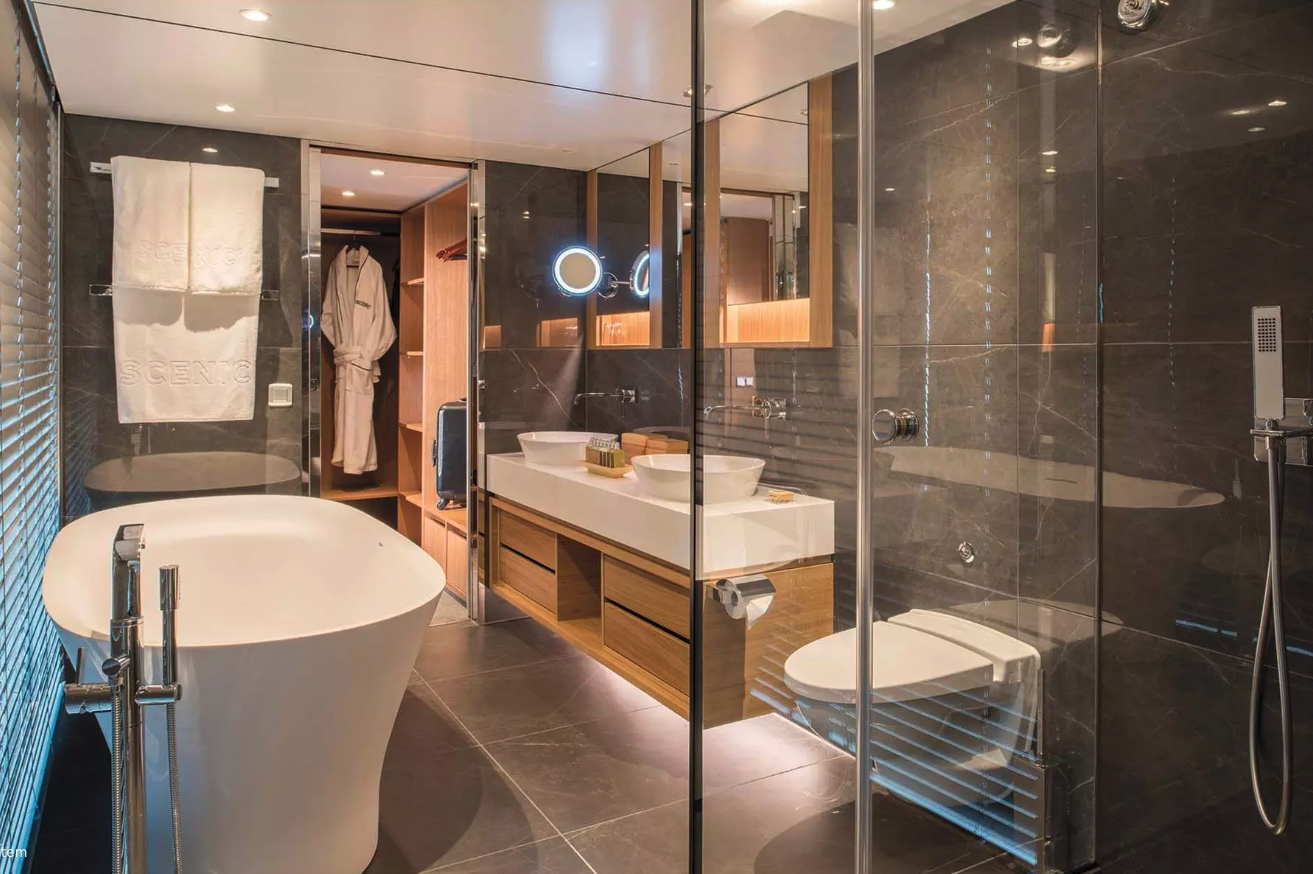

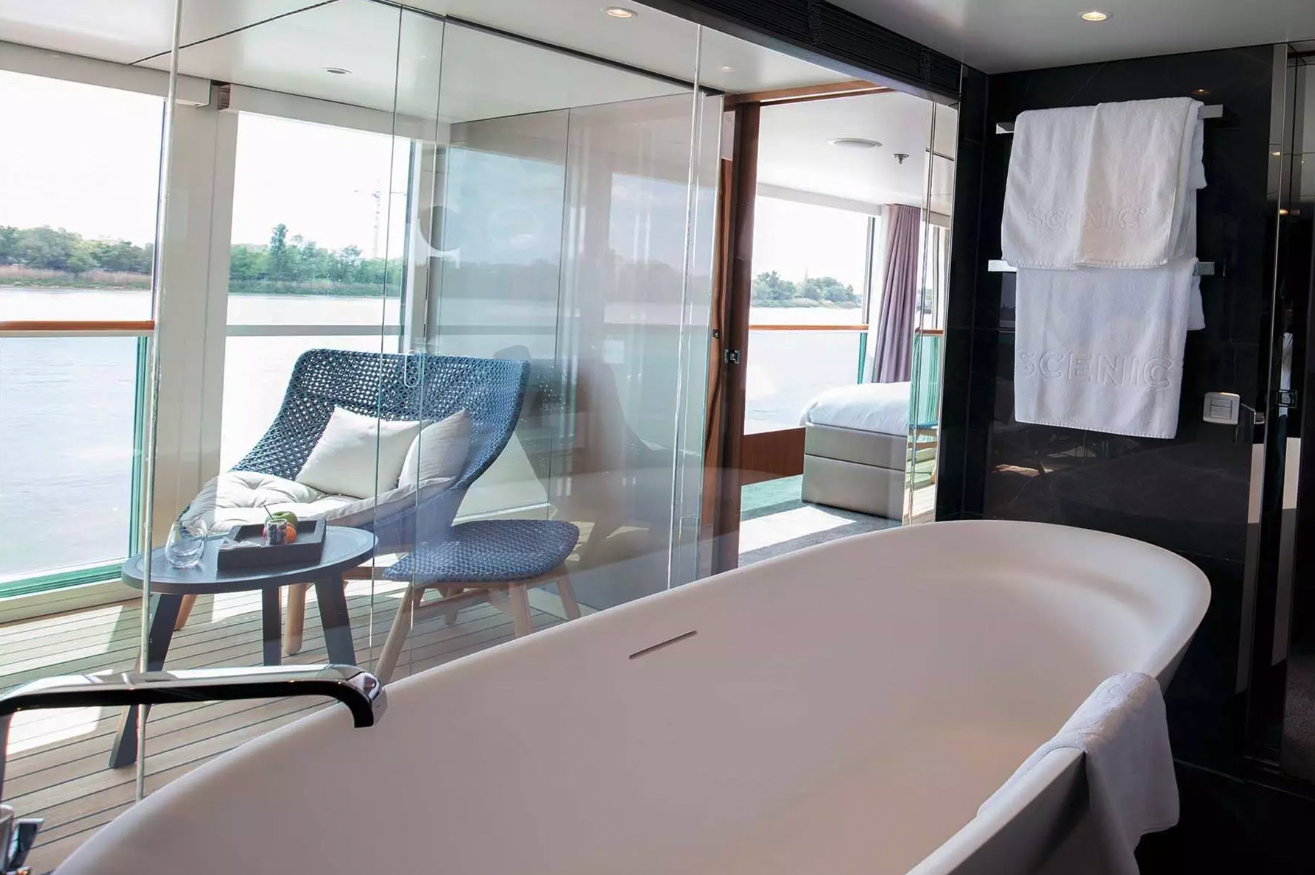
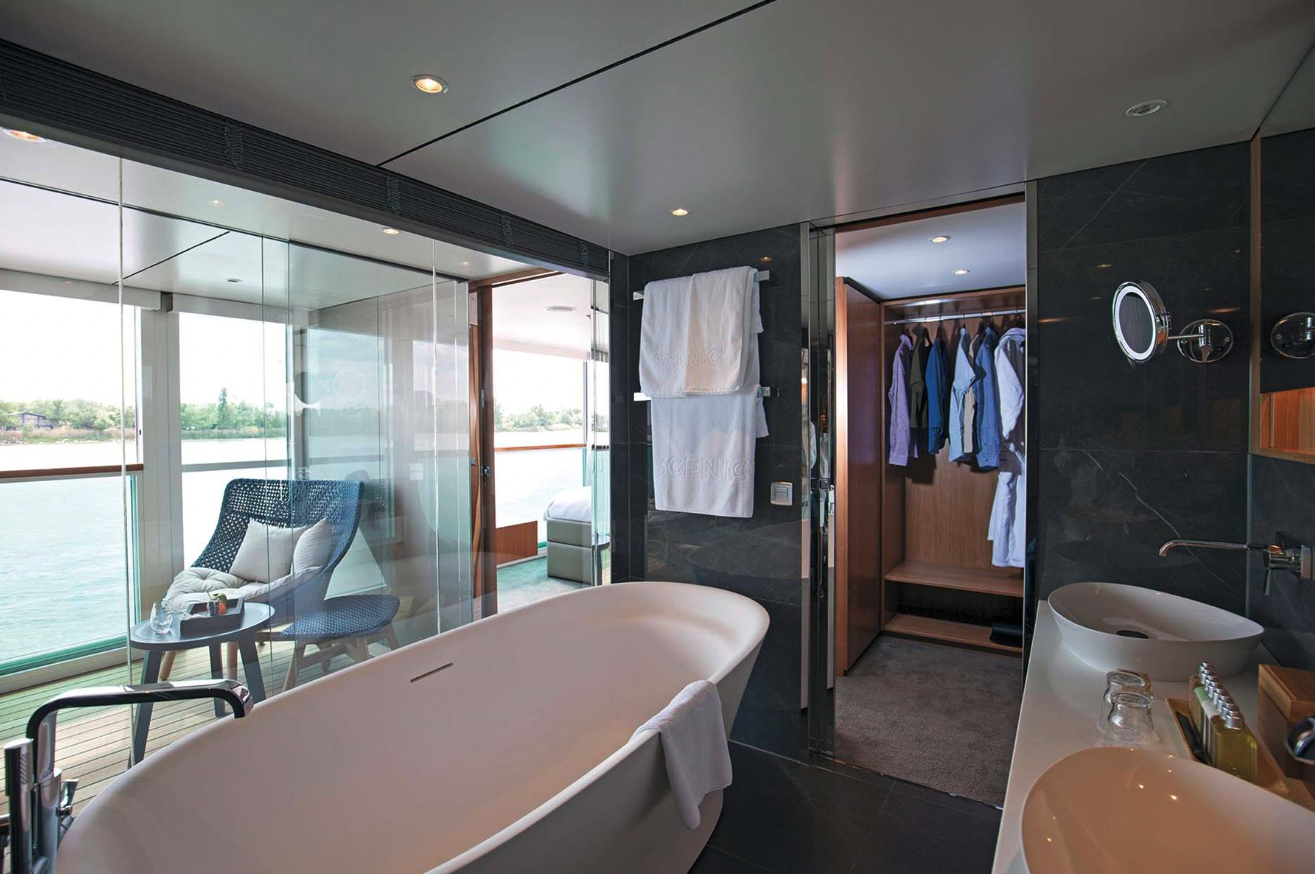


These Suites located on the Diamond Deck are the ultimate in luxury with more space, impeccable service, thoughtful touches, an outdoor balcony, lounge area and an oversized bathroom.
Suite Highlights
- A luxury queen sized Scenic Slumber Bed
- Scenic Sun Lounge, for wide-angle splendour at the press of a button
- Separate lounge area
- Oversized bathroom with separate shower and bath, and upgraded bathroom amenities
Amenities & Features
- Exclusive invitation to dine at Table La Rive or Table d’Or
- Priority reservations at selected dining venues
- A complimentary welcome bottle of champagne (750ml)
- €200 per suite on board credit for use in the Wellness Centre
- Private arrival and departure transfers in Europe*
- Personalised butler service, including unlimited complimentary laundry, shoeshine and valet, early morning tea and coffee services and a daily delivery of savoury and sweet canapés or fruit
- Mini bar, replenished daily
- Pillow menu, including anti-aging, low-allergy and memory-foam neck pillows
- Nightly turndown service
- Bathrobes and slippers
- In-suite safe



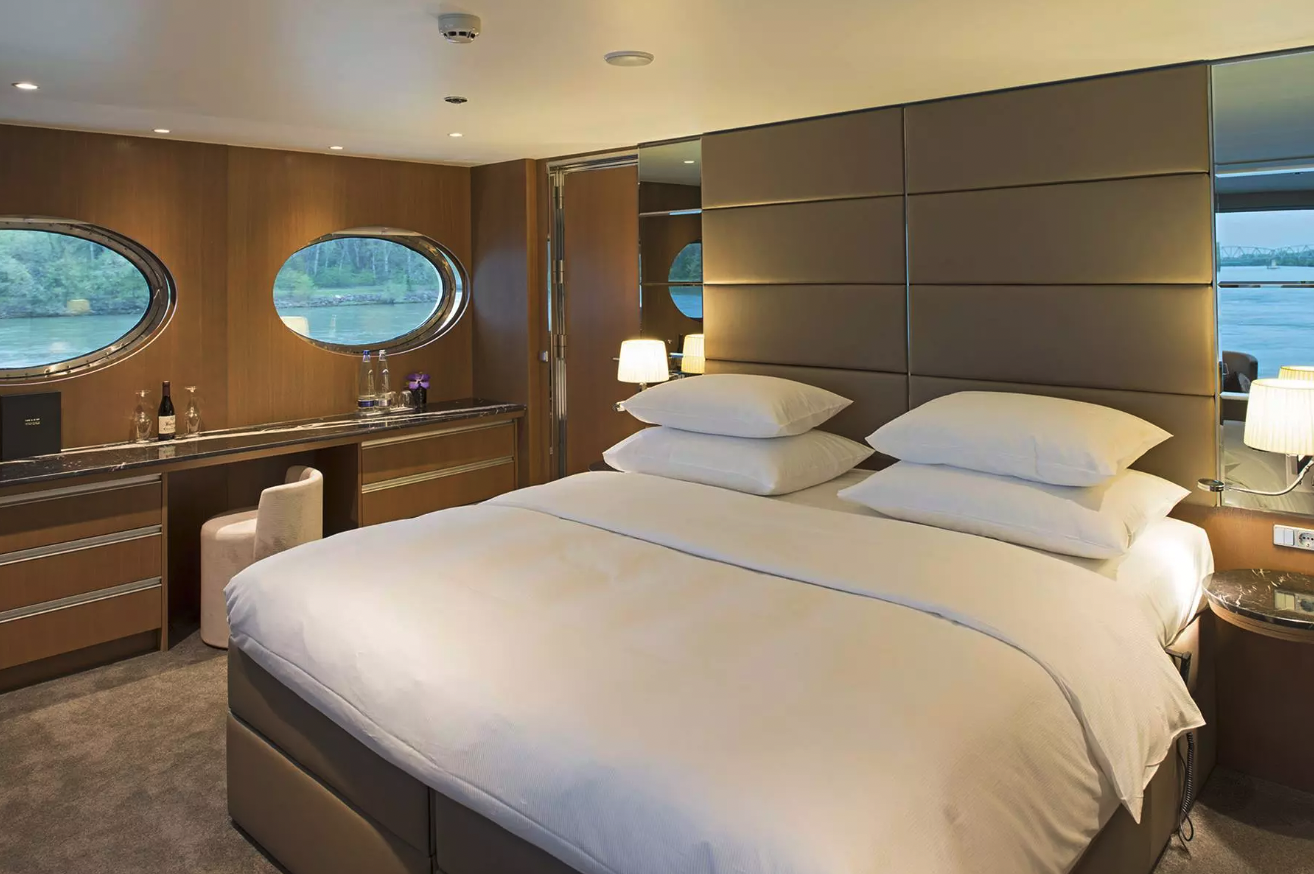

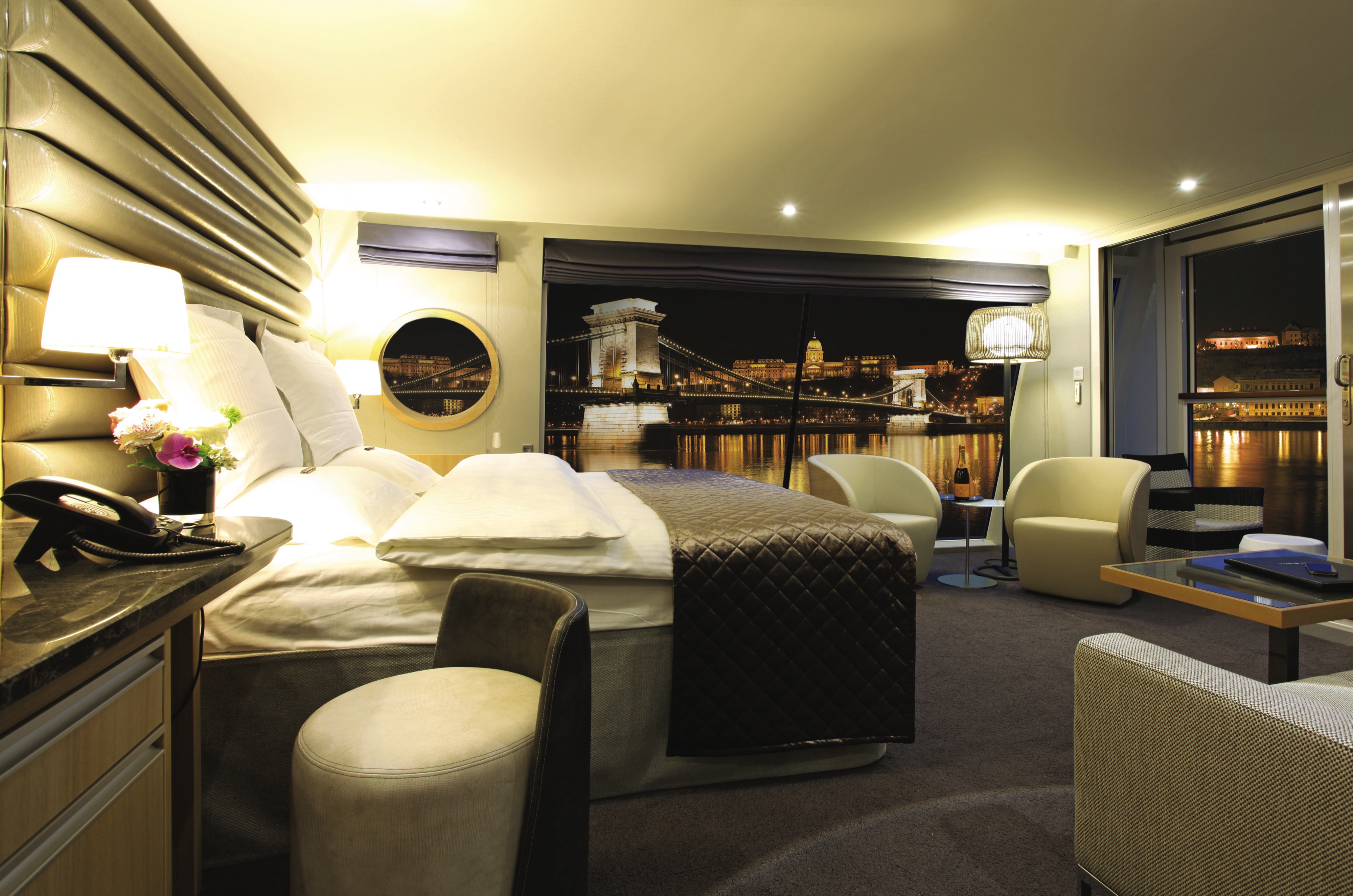
These Suites located on the Diamond Deck are the ultimate in luxury with more space, impeccable service, thoughtful touches, an outdoor balcony, lounge area and an oversized bathroom.
Suite Highlights
- A luxury queen sized Scenic Slumber Bed
- Scenic Sun Lounge, for wide-angle splendour at the press of a button
- Separate lounge area
- Oversized bathroom with separate shower and bath, and upgraded bathroom amenities
Amenities & Features
- Exclusive invitation to dine at Table La Rive or Table d’Or
- Priority reservations at selected dining venues
- A complimentary welcome bottle of champagne (750ml)
- €200 per suite on board credit for use in the Wellness Centre
- Private arrival and departure transfers in Europe*
- Personalised butler service, including unlimited complimentary laundry, shoeshine and valet, early morning tea and coffee services and a daily delivery of savoury and sweet canapés or fruit
- Mini bar, replenished daily
- Pillow menu, including anti-aging, low-allergy and memory-foam neck pillows
- Nightly turndown service
- Bathrobes and slippers
- In-suite safe

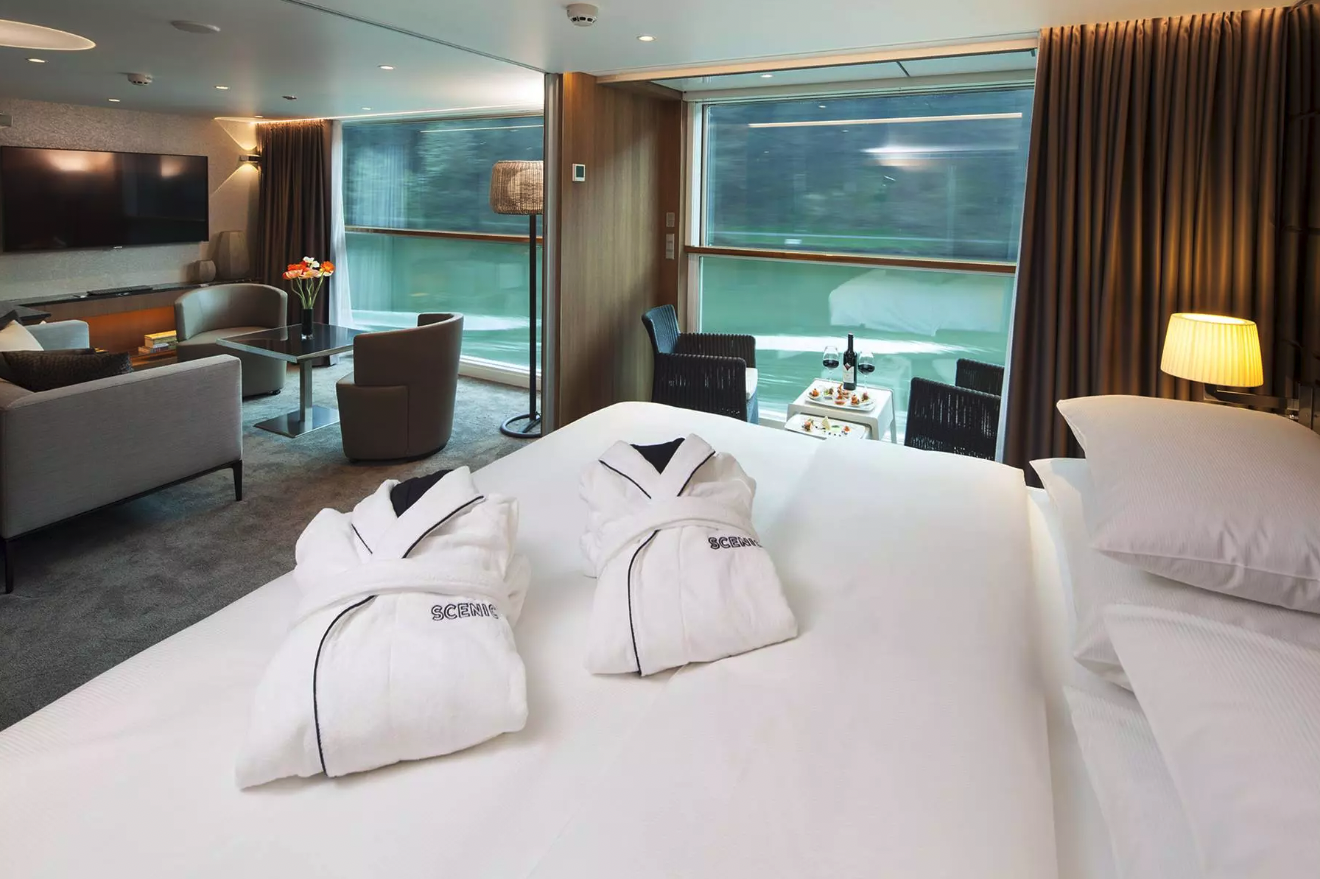

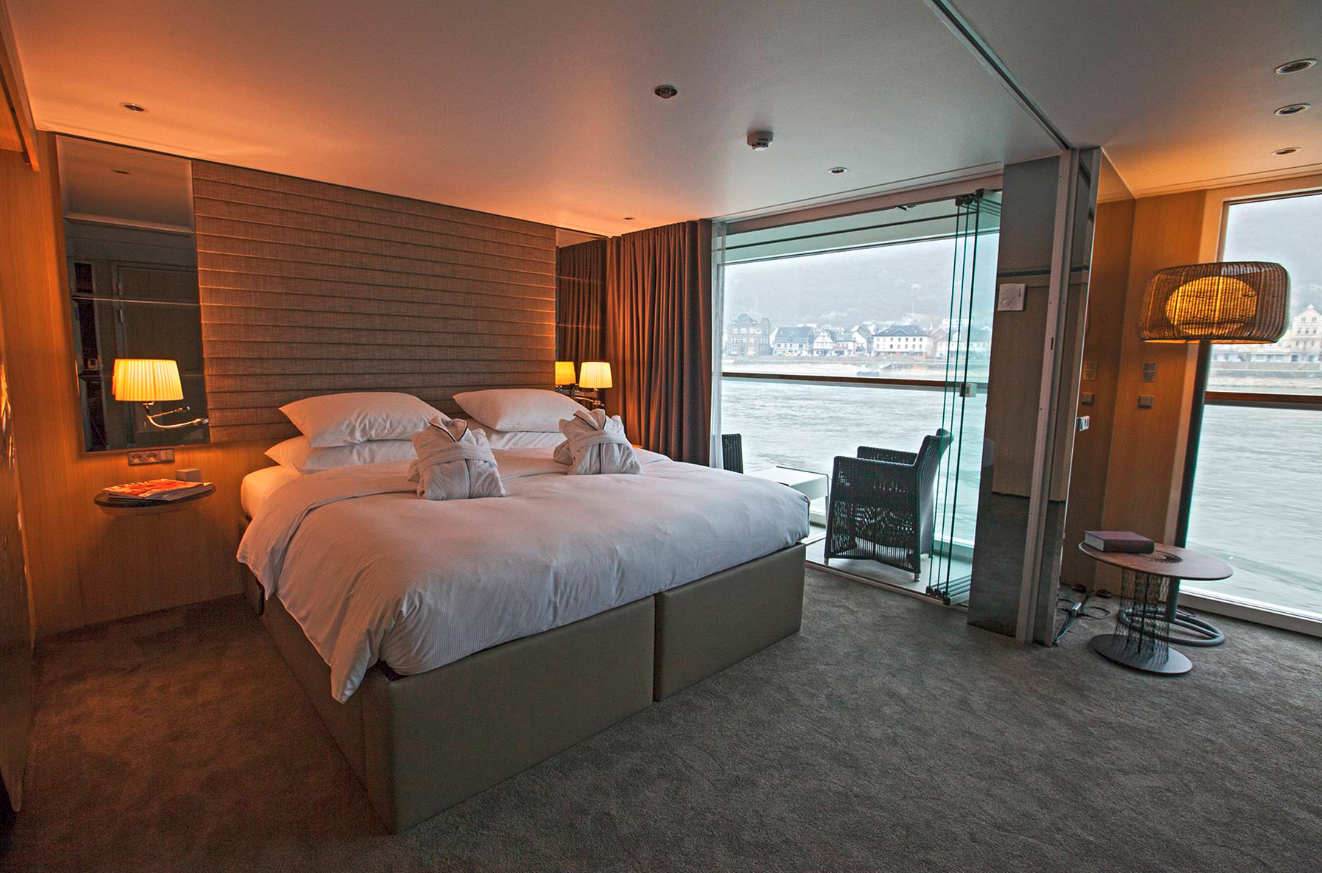

Located in prime locations at the front of the ship on both the Sapphire and Diamond Decks, they offer all the features of our private Balcony Suites with our ingenious Scenic Sun Lounge, but with even more space to relax.
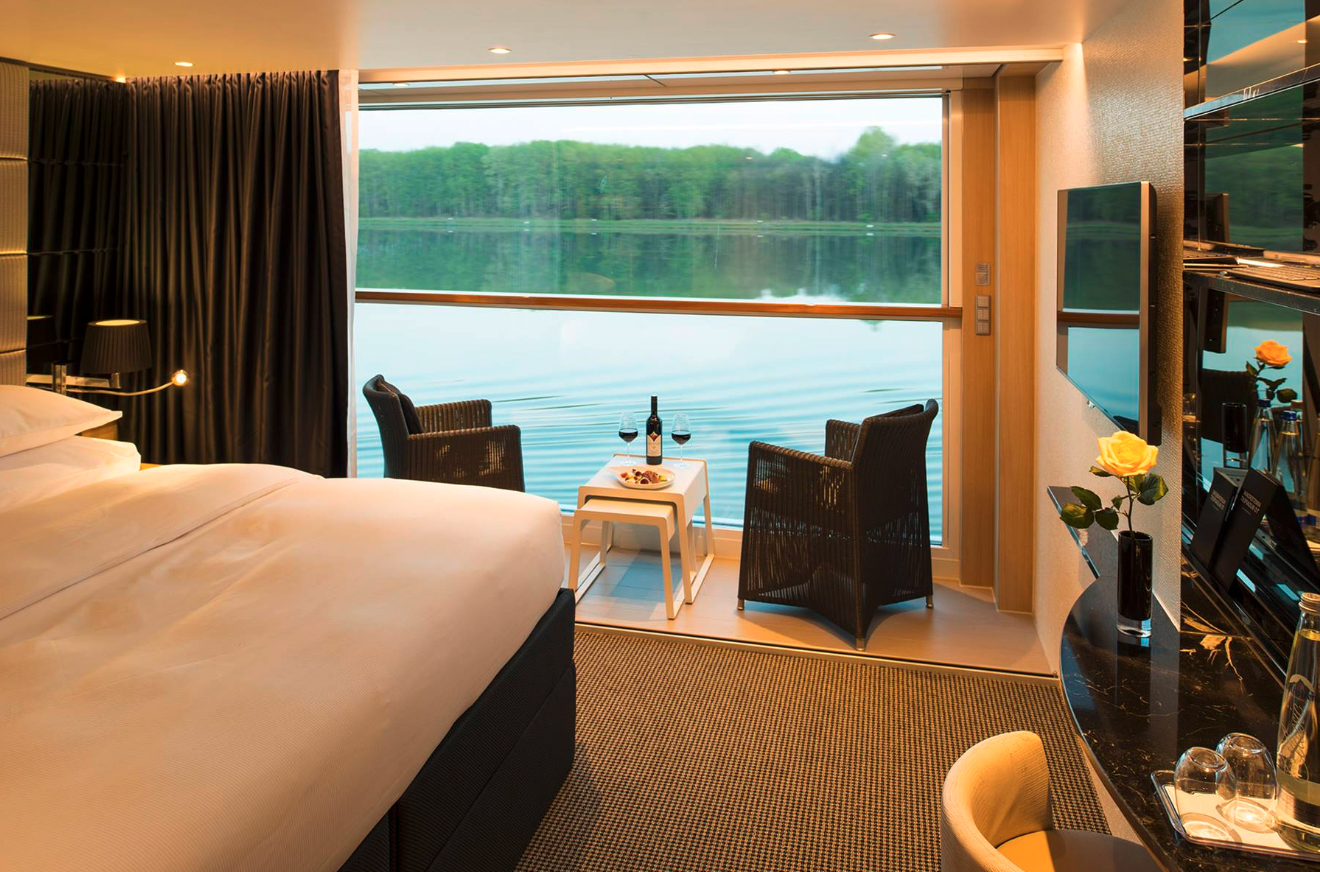
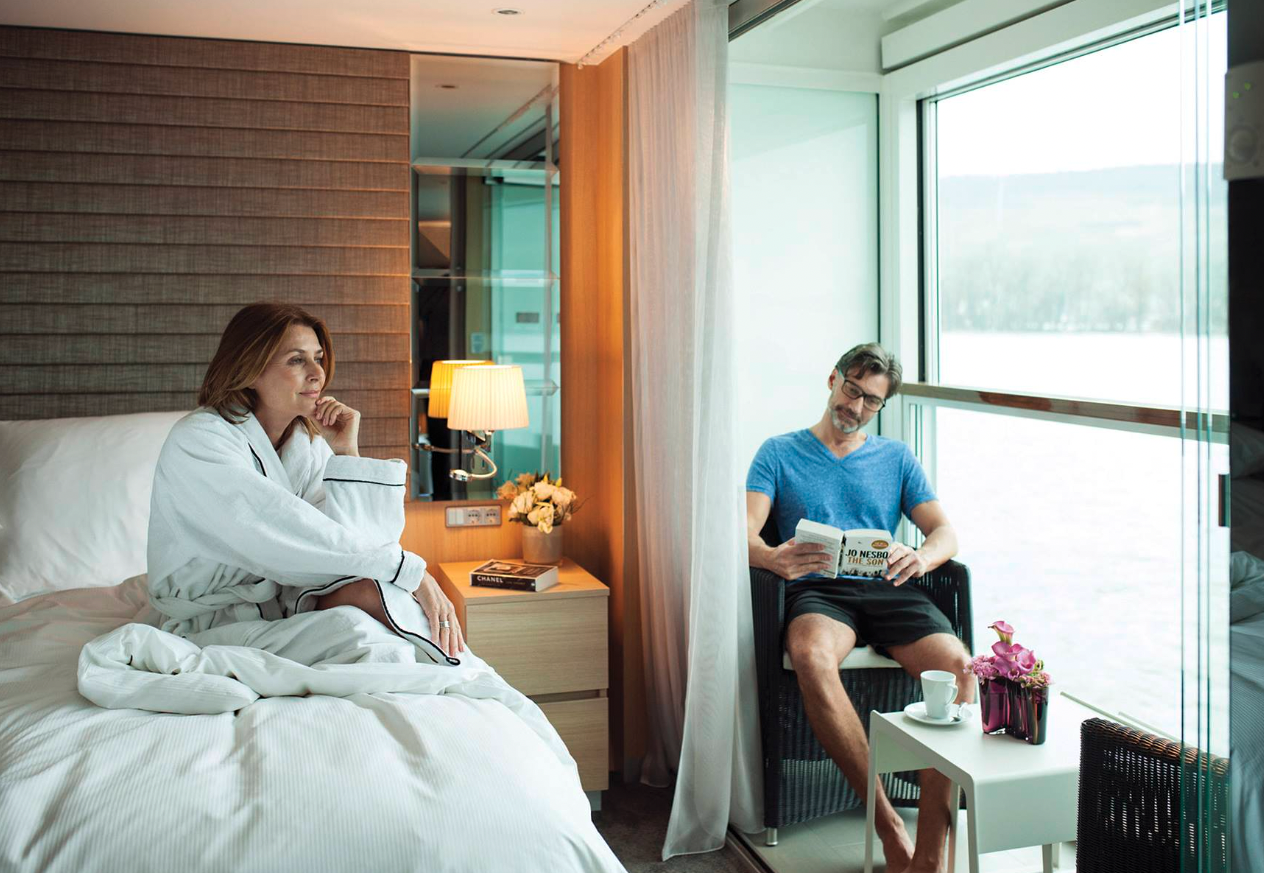
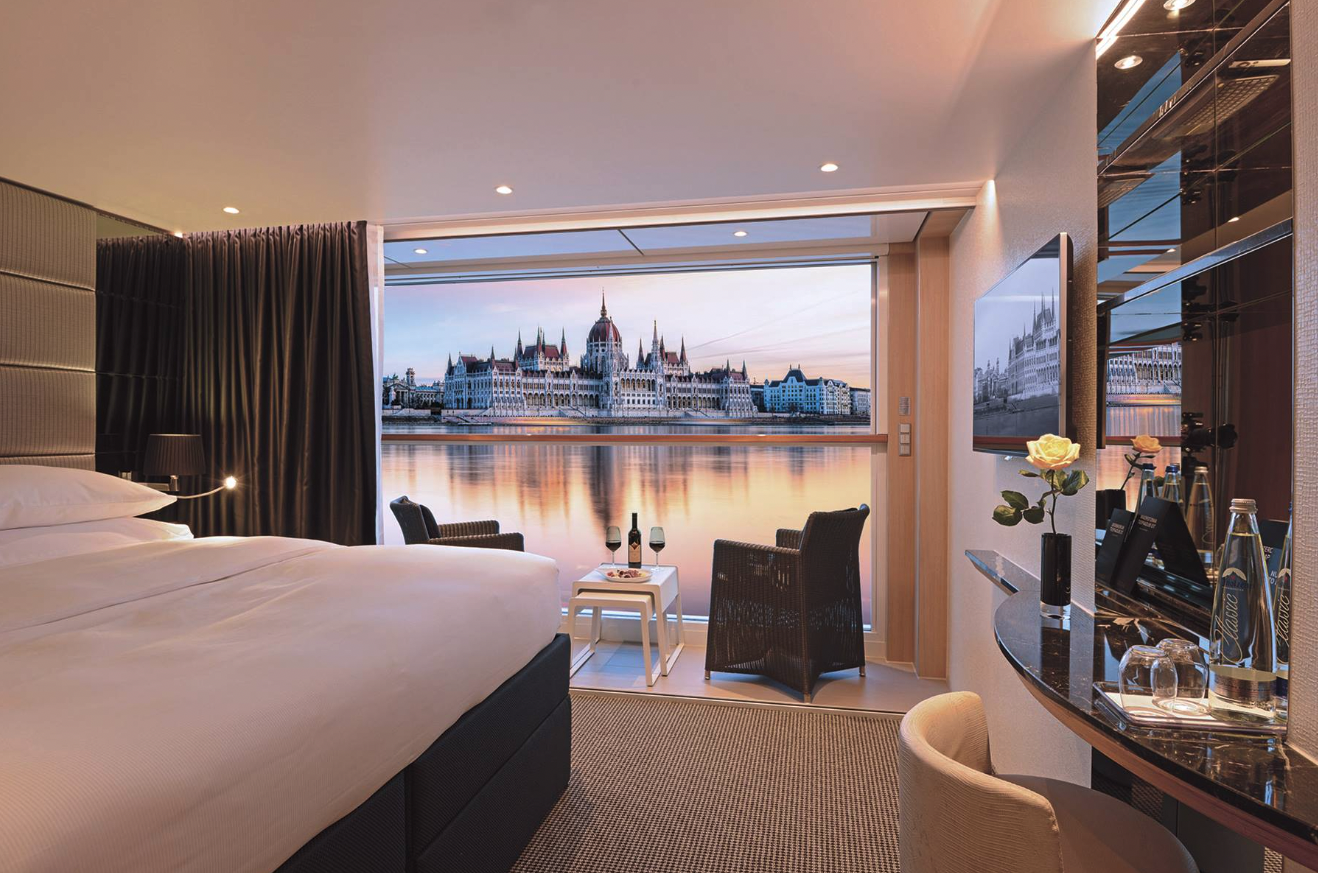
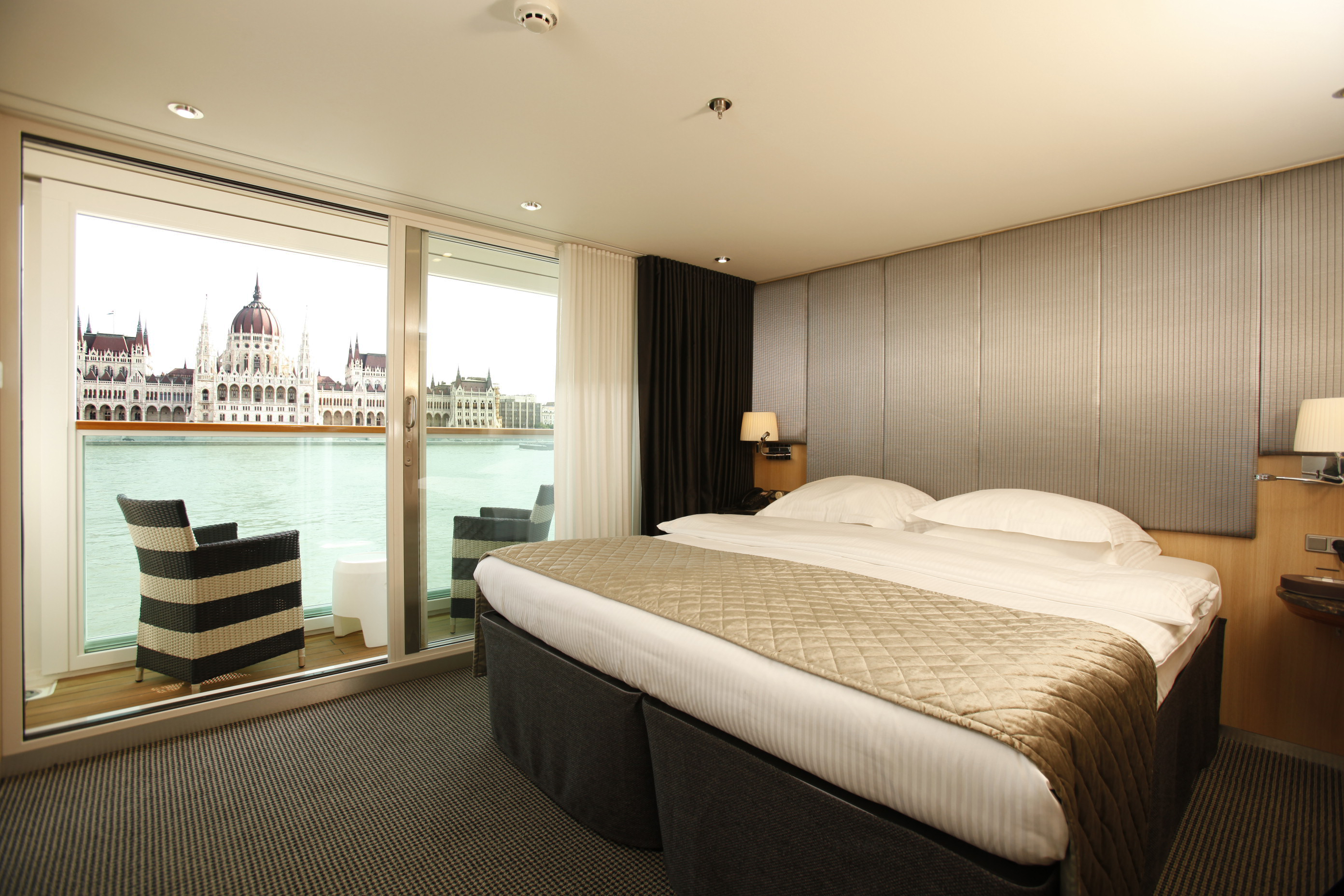
These spacious Suites, located on the Sapphire and Diamond Decks, have a private full-length balcony complete with a Scenic Sun Lounge and elegant en-suite bathrooms featuring a large vanity basin and shower.
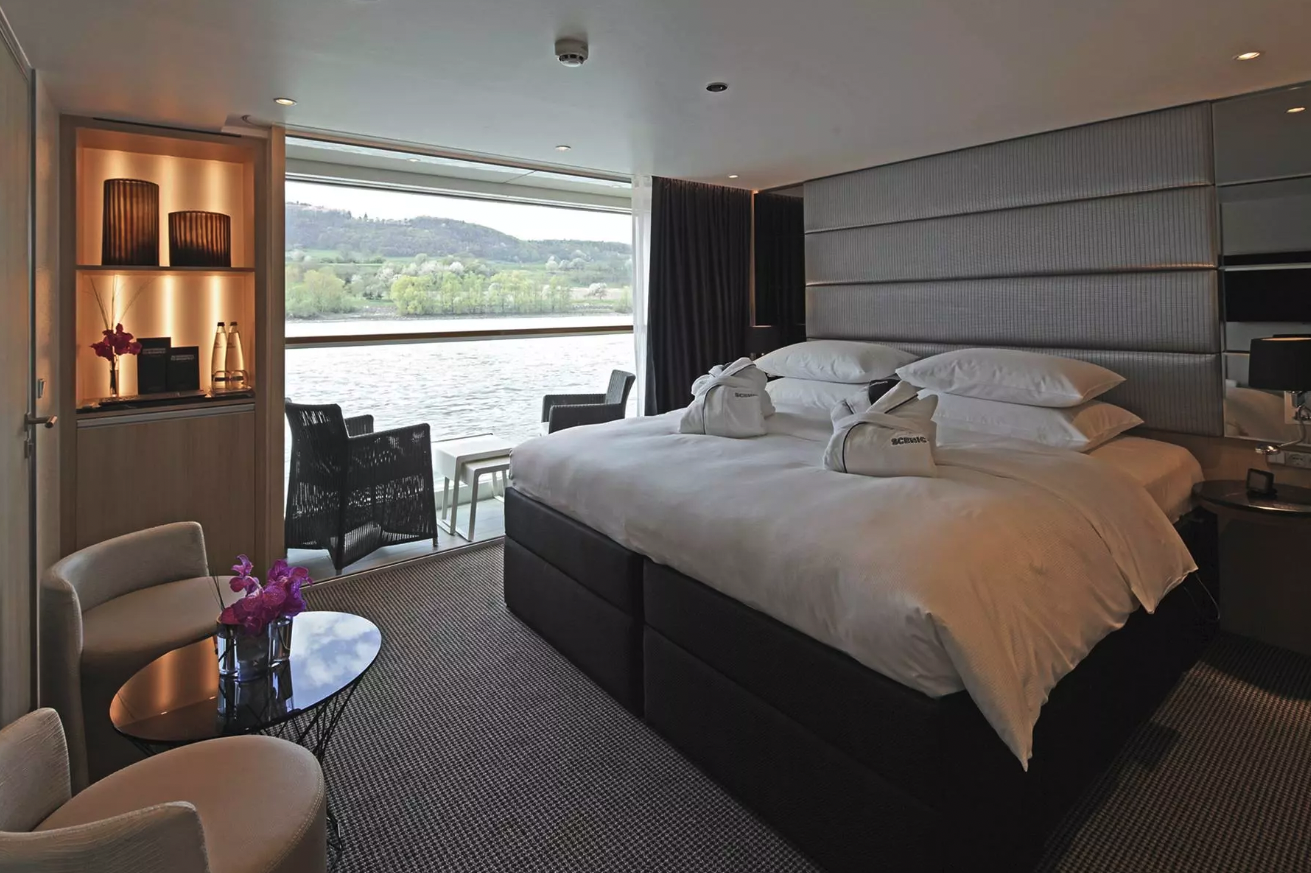
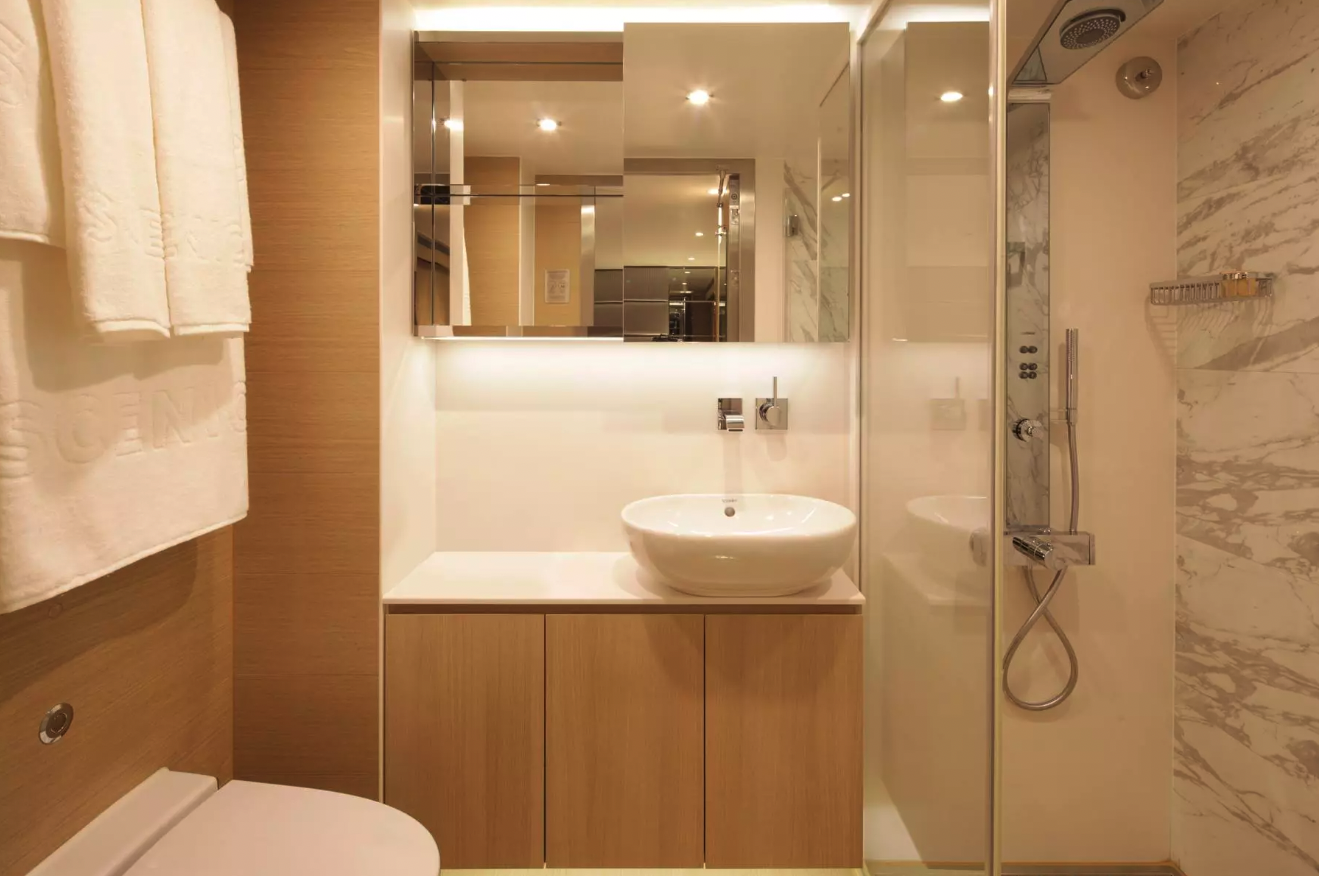

Located on the Sapphire and Diamond Decks these stylishly decorated suites feature a full-length outdoor balcony with the exclusive Scenic Sun Lounge and offer private bathrooms with a luxurious vanity basin and shower.
Room Highlights
- A luxury queen sized Scenic Slumber Bed
- Scenic Sun Lounge, for wide-angle splendour at the press of a button
- Spacious bathroom with luxurious amenities
Amenities & Features
- Personalised butler service for every suite
- Complimentary laundry service once per suite
- Early morning tea and coffee
- Beverage service in your suite
- Mini bar, replenished daily
- Pillow menu, including anti-aging, low-allergy and memory-foam neck pillows
- Nightly turndown service
- Bathrobes and slippers
- In-suite safe
- Shoeshine and valet service.






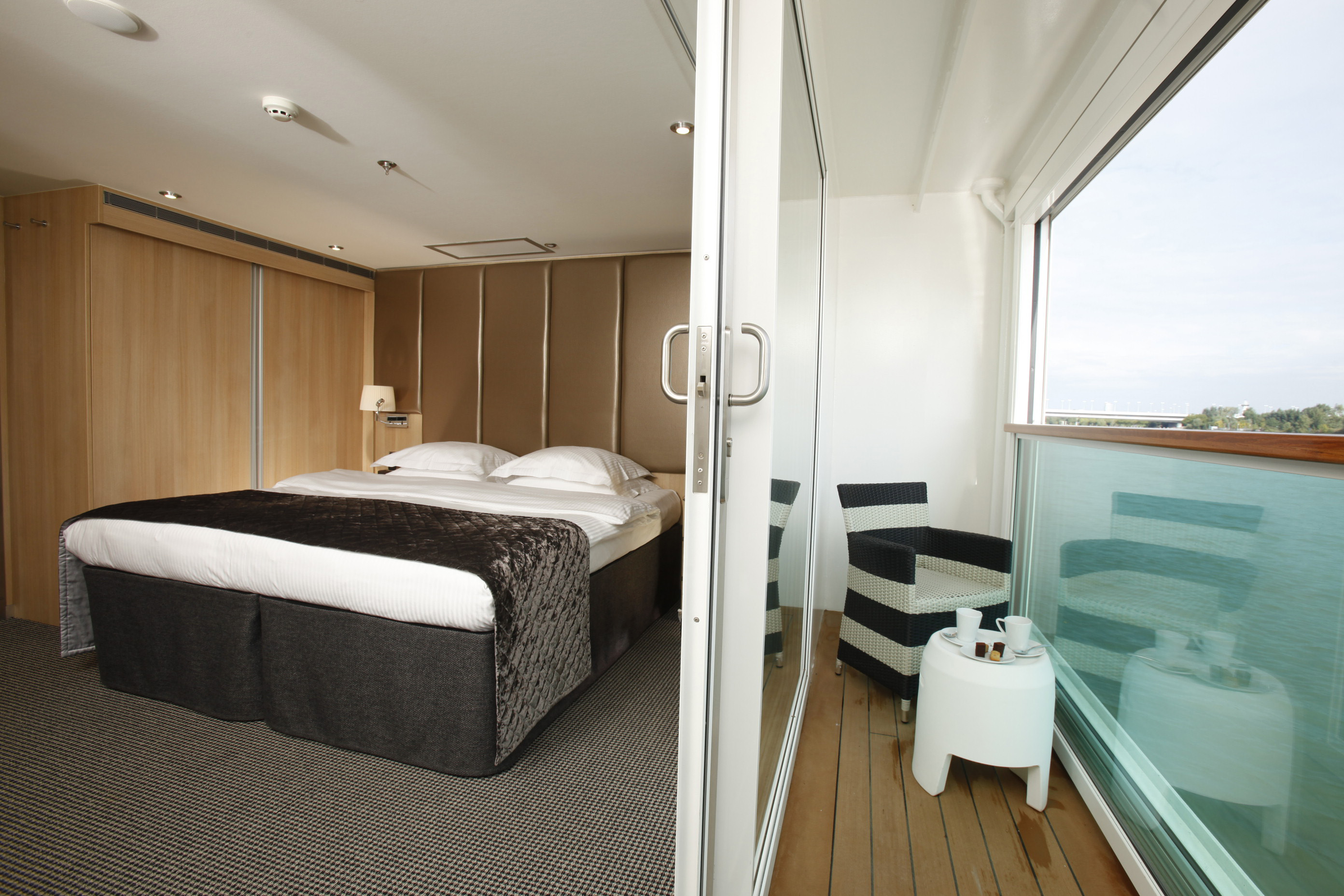
Located on the Sapphire deck this suite is perfect for the solo traveller. Enjoy fantastic views from your full size balcony complete with Scenic Sun Lounge. This cabin also includes an elegant bathroom with a luxurious vanity basin and shower.
Room Highlights
- A luxury queen sized Scenic Slumber Bed
- Scenic Sun Lounge, for wide-angle splendour at the press of a button
- Spacious bathroom with luxurious amenities
Amenities & Features
- Personalised butler service for every suite
- Complimentary laundry service once per suite
- Early morning tea and coffee
- Beverage service in your suite
- Mini bar, replenished daily
- Pillow menu, including anti-aging, low-allergy and memory-foam neck pillows
- Nightly turndown service
- Bathrobes and slippers
- In-suite safe
- Shoeshine and valet service.


Staterooms are located on the Jewel Deck with large picture windows to ensure a great view. They have a spacious design and clever layout alongside all the usual luxurious amenities and furnishings.
The bedroom area has a Queen-size Scenic 'Slumber bed' with Egyptian cotton linen and pillow menu. The bathroom with shower, is well stocked with L'Occitaine toiletries as well as a hairdryer, bathrobes and slippers. The suite also contains a complimentary in-suite mini-bar, restocked daily. The suite has a Flat screen HDTV linked to Mac Mini, complementary WiFi and use of a telephone. A safe is also provided for your valuables.
Guests staying within this suite receive butler service that includes valet and shoeshine service, drinks and cocktails.


Scenic Crystal
Scenic Crystal, Jade & Jewel were the sixth, seventh, and eighth ships to join our fleet of luxury Space-Ships respectively. All three river cruise ships feature our signature Scenic Sun Lounges, as well as newly designed cabins and suites.
With four sumptuous decks boasting a selection of private suites and public lounge and dining venues, every aspect of Scenic Crystal, Jade & Jewel has been carefully considered to be easily navigable and wonderfully luxurious.
Enjoy an ultra-luxury ship experience on board our luxurious Scenic Space-Ships in Europe. With only up to 163 guests, you will enjoy unrivalled amenities and an abundance of spaces to relax, while gliding along beautiful European waterways.
These sleek ships are designed to navigate Europe’s rivers with ease, whilst providing abundant space to relax and indulge. Our ships provide a more personalised and intimate environment so you can sit back and enjoy the all-inclusive ultra-luxury experience.
As you’d expect from three valued members of the luxury Scenic Space-Ship fleet, comfort, refinement and luxury are second to none aboard Scenic Crystal, Jade & Jewel. The sister ships offer a number of different suite classes spanning three decks, so you have plenty of choice and flexibility depending on your individual travel preferences.
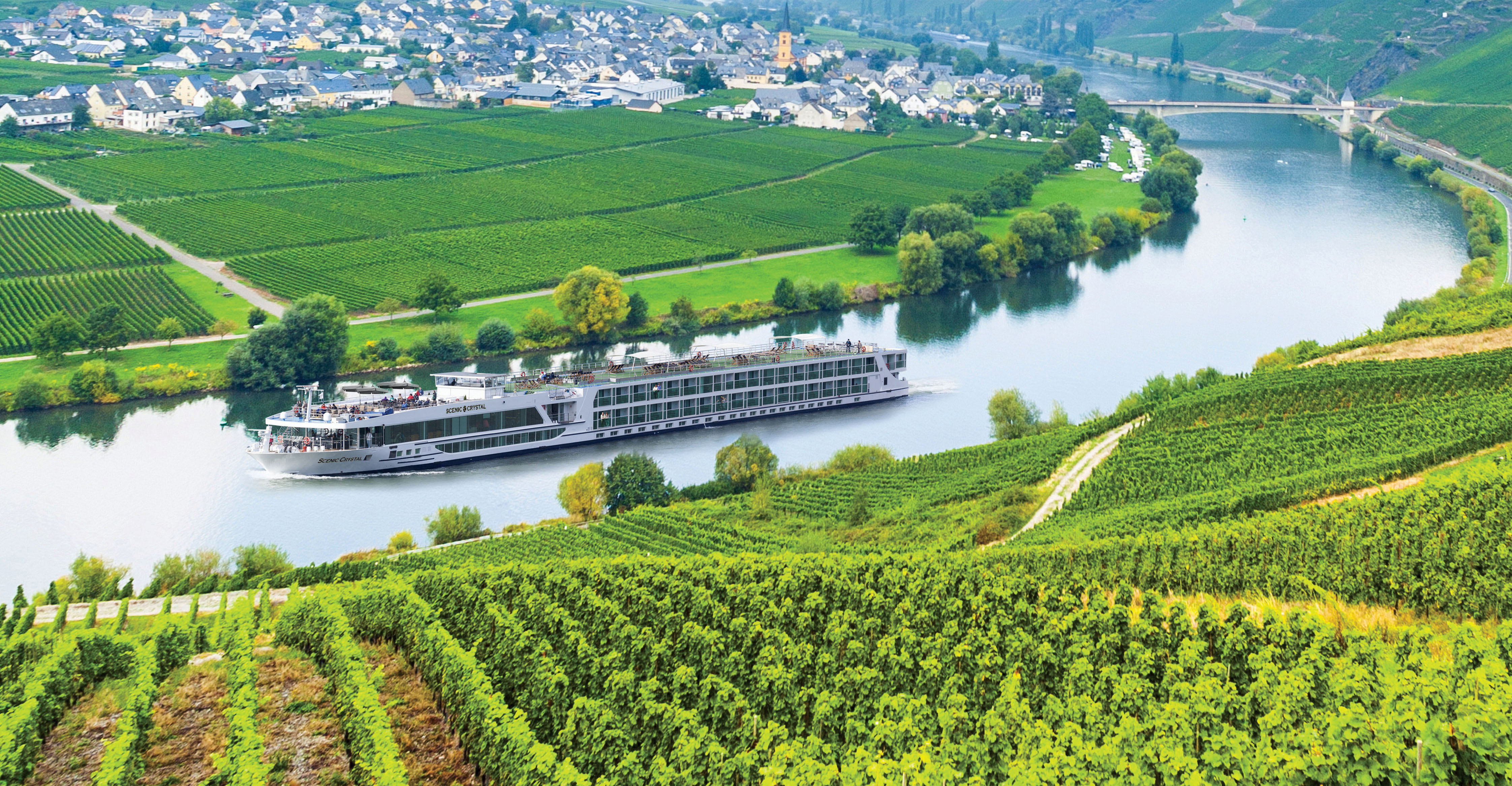
Ship Facts
| Launch Year | 2012 | ||||||
| Refit Year | |||||||
| Language | en | ||||||
| Gross Tonnage | 2721 | ||||||
| Length | 135 | ||||||
| Width | N/A | ||||||
| Currency | EUR | ||||||
| Speed | N/A | ||||||
| Capacity | 163 | ||||||
| Crew Count | 55 | ||||||
| Deck Count | 4 | ||||||
| Cabin Count | 82 | ||||||
| Large Cabin Count | 0 | ||||||
| Wheelchair Cabin Count | 1 | ||||||
| Electrical Plugs |
|
Sun Deck
- Riverview Terrace
- Wheelhouse
- Sun Deck
- Walking Track

Diamond Deck
- Panorama Deck
- Portobellos Restaurant
- River Cafe
- Panorama Lounge and Bar
- Gift Shop
- Reception
- Elevator
- Royal Panorama Suite RS
- Balcony Suite A
- Royal Balcony Suite RA & R
- Deluxe Balcony Suite PD
- Junior Balcony Suite RJ
- Royal Owner's Suite RO

Sapphire Deck
- Gallery
- Table La Rive
- Crystal Dining Restaurant
- Elevator
- Junior Balcony Suite BJ
- Deluxe Balcony Suite BD
- Balcony Suite C
- Single Balcony Suite BS

Jewel Deck
- Wellness Area
- Fitness Centre
- Salt Therapy Lounge
- Standard Suite Cat E

Scenic Space-Ships feature up to five dining venues and our culinary team creates dishes inspired by the regional cuisines of the countries you cruise through. Whether it’s a three-course meal at Crystal Dining, a casual snack at River Café, or dining in the privacy of your suite, there is something for every palate and mood.
Crystal Dining
Portobellos
With up to only 32 guests an evening, the exclusive and intimate Portobellos or L’Amour showcase sumptuous regional specialities. The delectable five-course menu features either Italian, French or Portuguese cuisine (depending on your cruise location), paired with elegant wines, and is available on all European river cruises.
Table La Rive
Featuring a six-course degustation, the exclusive Table La Rive and Table d’Or on our European river cruises offers an intimate dining experience for only 10 guests per evening. Guests staying on the Diamond Deck for 10 nights or longer, as well as Royal and Junior Suite guests staying for up to nine nights, will be invited by our Executive Chef.
Riverview Terrace
Enjoy a refreshing afternoon aperitif or pick-me-up light bite on the Riverview Terrace, an open-air lounge and bar area located on the Sun Deck. Alfresco living doesn’t get better, with all-inclusive refreshments to complement the rapturous views.
River Cafe
Offering a casual dining experience, you can enjoy all-day grazing options, light snacks and tasty treats to suit your schedule. The River Café is available on all Europe and South East Asia river cruises.
In-Suite Dining
When you board a Scenic Space-Ship, you’ll unpack your bags and settle into your spacious and luxurious suite. Spend your days exploring the abundant spaces with multiple dining experiences, bars and lounges. Marvel at the panorama of Europe’s captivating waterways passing by.
Panorama Lounge & Bar
Explore our extensive wine list, relax with a coffee or catch-up with new-found friends at the Panorama Lounge & Bar. This is the main bar lounge on-board our Space-Ships, and it’s tastefully furnished to guarantee your comfort and enjoyment.
The Sun Deck
Make the most of every ray of sunshine with our purpose-built Sun Deck. Complete with deck chairs and a games area, this is a place to kick back and enjoy the view as your Space-Ship travels to its next destination.
Reception
Whatever you need on your cruise through Europe, our welcoming reception team is here to ensure your trip goes down without a hitch. The reception area is also the meeting point for the day’s shore excursions; you’ll find it in the middle of the Scenic Crystal.
Wheelhouse
The Wheelhouse is where our expert crew pilot your Space-Ship, negotiating the twists and turns of the Danube with the utmost precision and care. Stop by to chat with the team and take a peek behind the scenes.
Gallery
Our Gallery spaces are dedicated to showcasing works by local artists, so you feel connected to people and place in every destination. We believe little touches like this are what make our European river cruises so special.